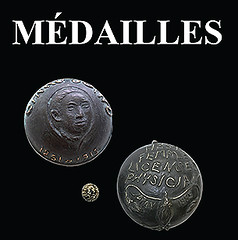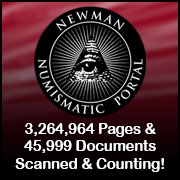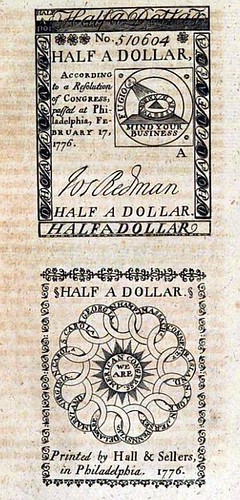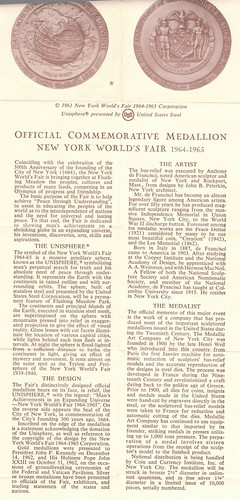
Visit our NBS Sponsors


About UsThe Numismatic Bibliomania Society is a non-profit association devoted to the study and enjoyment of numismatic literature. For more information please see our web site at coinbooks.org SubscriptionsThose wishing to become new E-Sylum subscribers (or wishing to Unsubscribe) can go to the following web page link MembershipThere is a membership application available on the web site Membership Application To join, print the application and return it with your check to the address printed on the application. Print/Digital membership is $40 to addresses in the U.S., and $60 elsewhere. A digital-only membership is available for $25. For those without web access, write to: Charles Heck, Treasurer AsylumFor Asylum mailing address changes and other membership questions, contact Chuck at this email address: treasurer@coinbooks.org SubmissionsTo submit items for publication in The E-Sylum, write to the Editor at this address: whomren@gmail.com BUY THE BOOK BEFORE THE COINSale Calendar |
- WAYNE'S WORDS: THE E-SYLUM MARCH 28, 2021
- COLONIAL COIN COLLECTORS CLUB PUBLICATIONS
- KENNY SAMMUT NUMISMATIC LITERATURE SALE
- NEW BOOK: CHECK LIST AND RECORD BOOK
- QDB: JOURNEYS WITH AMERICA’S $10 GOLD COINS
- NNP ADDS INTERNATIONAL NUMISMATIC COUNCIL
- NEW CONTINENTAL DOLLAR EVIDENCE EMERGES
- MORE ON THE 1785 CONTINENTAL DOLLAR SALE
- MORE ON COLONIAL PAPER MONEY ILLUSTRATIONS
- THE NEW YORK WORLD'S FAIR MEDAL PROCESS SET
- NOTES FROM E-SYLUM READERS: MARCH 28, 2021
- THE LOUVRE COLLECTION ONLINE
- VOCABULARY TERM: CLAD, CLADDING
- HARRY JASON LELANDE (1871-1965)
- HARVEY STACK'S NUMISMATIC FAMILY, PART 92
- FUND DRIVE: GET ABE & BEN TO ROSEMONT
- SAN DIEGO SPEAKERS KORCHNAK AND FANNING
- RESEARCH USING IMAGING AND GOOGLE TRANSLATE
- ANS COIN PHOTOGRAPHY TIPS
- RECORD PRICE FOR 1822 HALF EAGLE
- RECORD PRICE FOR 1797 HALF DOLLAR
- RECORD PRICE FOR 1937 EDWARD VIII 5 POUNDS
- GOLD PLATE MONEY FROM FEUDAL JAPAN
- HERITAGE APRIL 2021 SALE FEATURES U.S. ERROR
- ENGELHARD ERROR BARS
- ANCIENT GREEK COINS DISCOVERED IN ROMANIA
- AINA COL. DAVID "MICKEY" MARCUS MEDAL
- WESTERBORK CENTRAL REFUGEE CAMP SCRIP
- BANK OF ENGLAND £50 ALAN TURING BANKNOTE
- £10 NOTE MISSING QUEEN'S FACE
- BANK OF ENGLAND £50 NOTE TEXTURE FEATURES
- VIRTUAL MARKET ENJOYS ASTONISHING SUCCESS
- PERSONAL PHOTO ORGANIZERS
- PAUL MANSHIP EXHIBIT
- THE 500-POUND POMADED PENNY PILE
- FEATURED WEB SITE: FIDEM
Click here to read the thin version on the web
Click here to subscribe
Click here to access the complete archive
To comment or submit articles, reply to whomren@gmail.com
Content presented in The E-Sylum is not necessarily researched or independently fact-checked, and views expressed do not necessarily represent those of the Numismatic Bibliomania Society.
WAYNE'S WORDS: THE E-SYLUM MARCH 28, 2021
 New subscribers this week include:
Aaron Curry.
Welcome aboard! We now have 6,638 subscribers.
New subscribers this week include:
Aaron Curry.
Welcome aboard! We now have 6,638 subscribers.
Thank you for reading The E-Sylum. If you enjoy it, please send me the email addresses of friends you think may enjoy it as well and I'll send them a subscription. Contact me at whomren@gmail.com anytime regarding your subscription, or questions, comments or suggestions about our content.
This week we open with two numismatic literature sales offerings, one new book, updates from the Newman Numismatic Portal, and more.
Other topics this week include the Continental Dollar, process medal sets, cladding, translation and photography tips, record coin prices, upcoming auction sales, errors, refugee camp scrip, the Alan Turing banknote, new virtual markets, Mickey Marcus and Paul Manship.
To learn more about colonial coinage and paper money, the International Numismatic Council, Medallic Art Co., Neziah Wright, Richard Driehaus, a mudlark find, the Louvre numismatic holdings, FIDEM, gold obans, Oily American Coppers, and explosion bonding, read on. Have a great week, everyone!
Wayne Homren
Editor, The E-Sylum
COLONIAL COIN COLLECTORS CLUB PUBLICATIONS
The Colonial Coin Collectors Club (C4) has rolled out a nice update to the Publications page on their website. It's a great one-stop shop for many of the best works published on the topic of U.S. colonial-era coinage. Check it out. -Editor
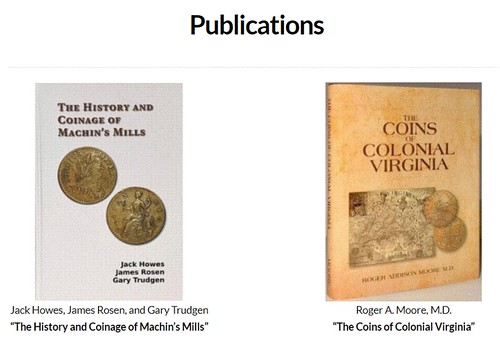
To visit the C4 Publications page, see:
https://colonialcoins.org/publications/
KENNY SAMMUT NUMISMATIC LITERATURE SALE
Kenny Sammut writes:
"I am having a 10 day sale on all numismatic books (very eclectic group of books) and five hundred of my coin, currency, and exonumia listings. Up to 25% off! You are also welcome to make fair offers on any listing you see. I do combine ship to save you money.
"International buyers - I do ship internationally using eBay's Global Shipping Program.
"Please use the category links on the left side of the store to more easily navigate the listings. I also welcome you to save me as a seller as I continually purchase collections and add new listings frequently.
"I recently purchased approximately 100 non-numismatic collecting books on a number of topics. Those books are also on sale."
Here's a screenshot of some of the literature offerings. Have a look for yourself. -Editor
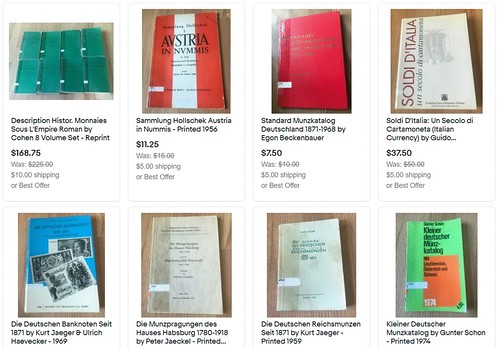
To visit Kenny's eBay store, see:
https://www.ebay.com/str/numismaticswithkenny

NEW BOOK: CHECK LIST AND RECORD BOOK
Whitman has published a new edition of their Check List and Record Book of United States and Canadian Coins. -Editor
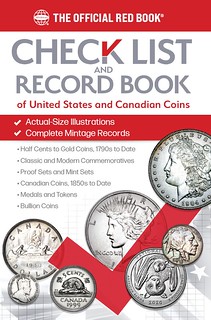 Whitman Publishing announces the release of the newly updated and expanded Check List and Record Book of United States and Canadian Coins, a resource to help hobbyists keep track of their collections. The 304-page softcover book is available from booksellers and hobby shops nationwide, as well as online (including at www.Whitman.com), for $9.95.
Whitman Publishing announces the release of the newly updated and expanded Check List and Record Book of United States and Canadian Coins, a resource to help hobbyists keep track of their collections. The 304-page softcover book is available from booksellers and hobby shops nationwide, as well as online (including at www.Whitman.com), for $9.95.
The Check List and Record Book of United States and Canadian Coins is a convenient way to keep track of a coin collection. Its 6 x 9–inch size packs a large amount of information into a handy resource that can be carried in a bag or briefcase, or stored in a safe deposit box. Collectors take the book to coin shops and conventions while they’re on the hunt for new numismatic acquisitions, checking each box as they add a coin or upgrade to a better specimen. The book also has room to write notes on when and where specific coins were bought, their grades, pricing, and any other information the collector wants to record.
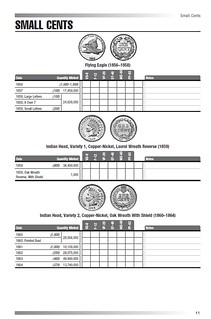
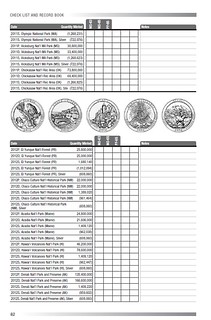
The Check List and Record Book features actual-size illustrations of each coin type, mintage records for circulation-strike and Proof coins, and coin-by-coin listings of every date and mint. The coins covered include U.S. half cents through gold double eagles, 1790s to date; classic and modern commemorative coins; government-issued commemorative sets; Proof sets and Mint sets; Canadian coins from the 1850s to date; and silver, gold, platinum, and palladium bullion coins. There are sections to keep track of collections of Hard Times tokens; Civil War tokens; other tokens and medals; Hawaiian coins; Puerto Rican coins; coins struck for the Philippines under U.S. sovereignty; misstrikes and error coins; and American Arts gold medallions. The Canadian chapters cover large cents; small cents; five-cent pieces and other circulating denominations; silver and modern coins; commemorative issues; dollar coins; and bullion.
Professional numismatists, appraisers, coin dealers, and experienced collectors know the importance of keeping an accurate inventory. Beth Deisher devotes an entire chapter to the subject in her award-winning book Cash In Your Coins: Selling the Rare Coins You’ve Inherited. Tom Bilotta, in Collecting Coins in Retirement: An Action Guide and Estate Advice for Hobbyists and Their Families, also stresses the value of maintaining accurate records.
“The Check List and Record Book helps you organize and build a better collection,” said Whitman publisher Dennis Tucker. “It can also be useful for tax and insurance purposes, and as a valuable record for your children and grandchildren to understand and appreciate your coins.”
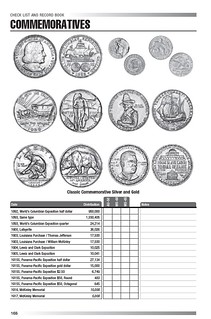
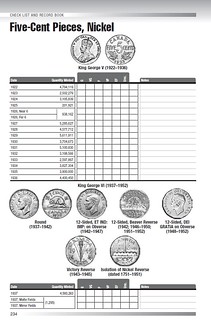
The new Check List and Record Book covers the United States Mint and the Royal Canadian Mint up through 2021, with extra space to keep track of later coins.
Check List and Record Book of United States and Canadian Coins
ISBN 0794849040
Softcover, 6 x 9 inches, 304 pages. Retail $9.95 U.S.
https://whitman.com/check-list-and-record-book-of-united-states-and-canadian-coins/
QDB: JOURNEYS WITH AMERICA’S $10 GOLD COINS
Here's another article by Dave Bowers, this time on the new edition of his book on gold eagles. -Editor
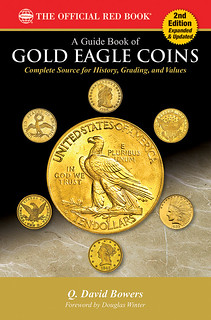 The second edition of the Guide Book of Gold Eagle Coins, by Q. David Bowers, debuted this month (March 2021). The 448-page book is available from bookstores and hobby shops and online (including at Whitman.com) for $29.95. Here, Bowers discusses the book and his research in American gold coins.
The second edition of the Guide Book of Gold Eagle Coins, by Q. David Bowers, debuted this month (March 2021). The 448-page book is available from bookstores and hobby shops and online (including at Whitman.com) for $29.95. Here, Bowers discusses the book and his research in American gold coins.
Highways and Side Journeys With America’s $10 Gold Coins
by Q. David Bowers
My research for the Guide Book of Gold Eagle Coins began in the 1950s—although I did not know it at the time. As a young teenager I studied and read all I could about rare coins. By 1954 I had a good working library and was keeping notes of interesting things I learned.
Fast-forward to adulthood, a highly successful rare-coin business, and other activities and pleasures. One of my greatest satisfactions continues to be research followed by writing on subjects from esoteric to popular.
My book on $10 gold eagles includes the basic foundation of information you expect to find in a volume in Whitman Publishing’s Bowers Series. Beyond that you can take many side excursions to explore mints and minting of days gone by, to acquaint yourself with great collectors and collections of the past, and to tap into many anecdotes, trivia, and stories that, I hope, will add to the charm of any $10 gold coin in your collection.
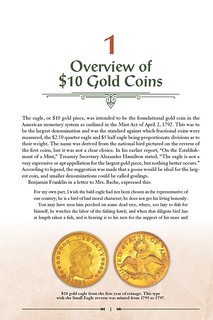
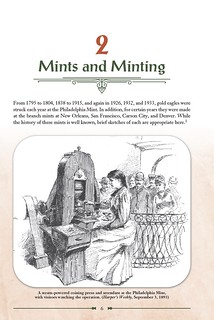
You will learn why a political movement that started in the West in the 1870s is directly responsible for countless hundreds of thousands of About Uncirculated and Mint State eagles being available to collectors today—one of the most remarkable unintended consequences in numismatics. You will also learn a lot about the market and the factors that influence change in coin values.
By the time you read the last page I believe you will be as familiar with gold eagles as is someone who has spent years in rare coins. Enjoy the journey, and your collection!
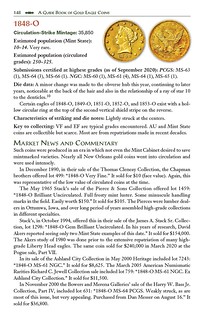
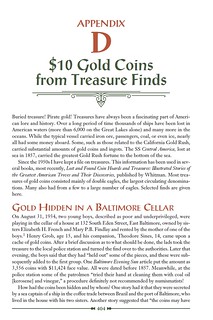
Q. David Bowers has been in the rare-coin business since 1953, including in recent years as a founder of Stack’s Bowers Galleries. He is a past president of the American Numismatic Association, a trustee emeritus of the New Hampshire Historical Society, and a fellow of the American Antiquarian Society. He has been a key numismatic consultant to the Smithsonian Institution since the 1960s, and has advised the United States Mint and Treasury Department. The author of more than 60 books including many standard references, he serves as numismatic director of Whitman Publishing, and is senior editor of Mega Red, the expanded edition of the Guide Book of United States Coins.
A Guide Book of Gold Eagle Coins, 2nd edition.
By Q. David Bowers; foreword by Douglas Winter.
ISBN 0794848370.
Softcover, 6 x 9 inches, 448 pages, full color.
Retail $29.95 U.S.
URL:
https://whitman.com/a-guide-book-of-gold-eagles-2nd-edition/
To read the earlier E-Sylum article, see:
NEW BOOK: GUIDE BOOK OF GOLD EAGLE COINS, 2ND
(https://www.coinbooks.org/v24/esylum_v24n06a03.html)
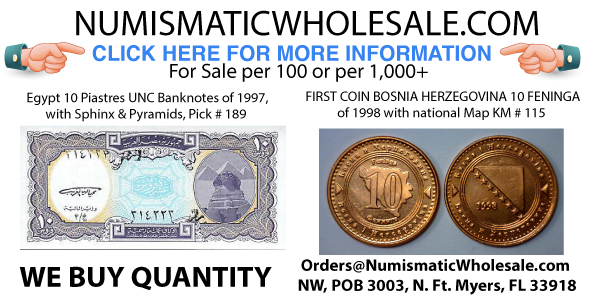
NNP ADDS INTERNATIONAL NUMISMATIC COUNCIL
The latest additions to the Newman Numismatic Portal are the publications of the International Numismatic Council (INC). Project Coordinator Len Augsburger provided the following report. -Editor
Newman Portal Digitizes International Numismatic Council Publications
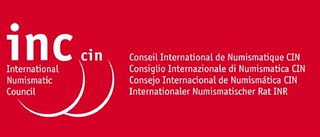 With the permission of the International Numismatic Council (INC), Newman Portal has digitized the publications of this longstanding academic initiative. The first INC Congress was held in 1891 and has been conducted periodically ever since, currently at 6-year intervals. The organization’s charter is “to promote numismatics and related disciplines by facilitating cooperation among individuals and institutions in the field of numismatics and related disciplines.” Publications include the Congress Proceedings and the Survey of Numismatic Research, also published every six years, which serves as a bibliography of the most significant recent numismatic research. INC also issued Compte Rendu beginning in 1951, an annual update with organization news and a number of research articles, such as John Kleeberg’s “Treasure Trove Law in the United States” (2006).
With the permission of the International Numismatic Council (INC), Newman Portal has digitized the publications of this longstanding academic initiative. The first INC Congress was held in 1891 and has been conducted periodically ever since, currently at 6-year intervals. The organization’s charter is “to promote numismatics and related disciplines by facilitating cooperation among individuals and institutions in the field of numismatics and related disciplines.” Publications include the Congress Proceedings and the Survey of Numismatic Research, also published every six years, which serves as a bibliography of the most significant recent numismatic research. INC also issued Compte Rendu beginning in 1951, an annual update with organization news and a number of research articles, such as John Kleeberg’s “Treasure Trove Law in the United States” (2006).
An anomaly in the INC Proceedings is the collected papers for the 1967 Congress (no. VII, held in Copenhagen). ANS Librarian David Hill remarked to Len Augsburger on February 11 “By the way, we seem to lack INC #7 (1967) Copenhagen, which I can’t believe.” After considerable investigation, the answer was revealed in the October 4, 1967 issue of Coin World, which reported “Owing to the prohibitive cost of publishing the proceedings in full, it has been decided that the papers will be published by the normal numismatic journals of those countries in whose language the papers were read.” Eric Newman’s paper for this Congress, “Lessons in Modern Day Counterfeiting,” appeared in the November 1967 Numismatist.
Newman Portal acknowledges Michael Alram (INC President), François de Callataÿ (INC Secretary), Ute Wartenberg Kagan (ANS President), David Hill (ANS Librarian), and Lara Jacobs (Internet Archive) for their assistance with this project.
Link to International Numismatic Council (INC) Proceedings on Newman Portal:
https://nnp.wustl.edu/library/publisherdetail/533904
Link to Survey of Numismatic Research on Newman Portal:
https://nnp.wustl.edu/library/publisherdetail/541672
Link to Compte Rendu on Newman Portal:
https://nnp.wustl.edu/library/publisherdetail/541673
NEW CONTINENTAL DOLLAR EVIDENCE EMERGES
Here's a VERY interesting addition to the Newman Numismatic Portal which relates to our recent discussions of the Continental dollar. Project Coordinator Len Augsburger provided the following report. -Editor
New Continental Dollar Evidence Emerges
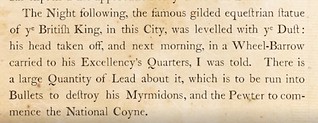 Nothing brings out new evidence more effectively than publishing one’s research, and a flurry of publications in the last few years is no doubt responsible for recent discoveries regarding the Continental Dollar, heretofore mostly unpublished. Recent writers on the subject include John Kleeberg (Journal of American Numismatics, June 2018), Catherine Eagleton (Numismatic Chronicle, 2014), Erik Goldstein and David McCarthy (The Numismatist, January and July 2018), and Maureen Levine and Eric Newman (The Numismatist, July 2014), with authors variously positing American or European origins. Lianna Spurrier has capably compiled the latest findings, drawn from historical and archaeological methods, into a video entitled King to Coins: New Origins of Continental Currency.
Nothing brings out new evidence more effectively than publishing one’s research, and a flurry of publications in the last few years is no doubt responsible for recent discoveries regarding the Continental Dollar, heretofore mostly unpublished. Recent writers on the subject include John Kleeberg (Journal of American Numismatics, June 2018), Catherine Eagleton (Numismatic Chronicle, 2014), Erik Goldstein and David McCarthy (The Numismatist, January and July 2018), and Maureen Levine and Eric Newman (The Numismatist, July 2014), with authors variously positing American or European origins. Lianna Spurrier has capably compiled the latest findings, drawn from historical and archaeological methods, into a video entitled King to Coins: New Origins of Continental Currency.
Image: Extract from Solomon Drowne letter of July 13, 1776, apparently referencing the Continental Dollar
Link to King to Coins: New Origins of Continental Currency on Newman Portal:
https://nnp.wustl.edu/library/book/597261

MORE ON THE 1785 CONTINENTAL DOLLAR SALE
Last week Julia Casey described some early mentions of U.S. colonial paper money and a Continental Dollar coin in German publications. She asked for reader assistance with translation. -Editor
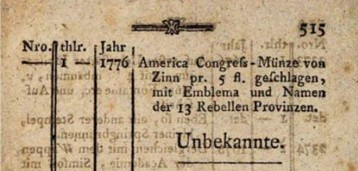
Ralf Böpple writes:
"With regard to the listing of the Continental dollar, the Google translation is correct, unfortunately I have no clue what "pr. 5 fl." could refer to. "fl." of course is usually the abbreviation of Gulden, but this makes little sense here. Maybe it's a description, known to the contemporary readers, stating that the coin is not made of pure tin, but an alloy (i.e., pewter)?"
Martin Purdy of New Zealand writes:
"Here's my best shot at this, though mileage may vary, as they say:
Fl is an abbreviation for florin, which was an alternative name for the Gulden, a unit of account in Bavaria. Wikipedia says the gulden was worth 5/12 of a Conventionsthaler from the 1750s to 1837, which covers the date of the catalogue. 5 gulden would thus be 25/12 or just over 2 Conventionsthaler. So I read this as meaning the Continental dollar was struck in tin (could cover other similar alloys, e.g. pewter), with a unit value of 2 thalers. At a pinch it could mean they were struck at a cost of 2 thalers each, but that sounds expensive, plus what would that imply? That they were made in Germany? It probably raises more questions than it answers but hopefully it will add at least something to the story.
I also thought "geschlagen" might have doubled as an older variant of "angeschlagen" (estimated), and that 5 fl. was the estimated sale price, but a text search of the whole catalogue doesn't bring up any comparable references, so at this stage I'd rule that out."
Peter Jones writes:
"In Bavaria the Gulden (also called Florin) was a unit of account according to Wiki. It was worth 60 Kreuzer. 60 Kreuzer or one gulden was 0.276 oz actual silver weight, and 5 gulden or florins were 1.38 ounces actual silver weight. Pr. 5 fl. could mean preis 5 florins (price 5 florins).
"This was then around 7 shillings and sixpence. But Sarah Banks' advertisement said only 6 pence (English) each! The period is too far from the 5 to be interpreted as 0.5 florins (around 9 pence English), and I cannot imagine advertising using decimal points in 1785.
"I also noted that below the listing was unbekannte which means "unknown". This makes me wonder whether this is really an advert to sell the piece at all, or just a listing."
Ralf Böpple adds:
"I don't think the "pr. 5 fl." is any indication of a price. The whole description reads "Münze von Zinn pr. 5 fl. geschlagen", which means "Coin coined of 'tin pr. 5 fl.'", which is why I think our unknown abbreviation is referring to a closer specification of the type of tin (or alloy) that was used. Unfortunately, the abbreviation 'pr.' is not used anywhere else in the whole catalog.
"The book as a whole is a list of the coins in the collection of one Mr. von Seuffenheld, to be sold in Nuremberg. Apparently, the whole collection was for sale, but no prices and no conditions of the sale are mentioned. There are some coins from Latin America, dutifully listed under Spain, as they were Spanish colonial issues. The only non-European non-Colonial coin is our Continental dollar, listed last in the "miscellaneous" section, right above the very last two entries, which are unknown items ("Unbekannt"). That much about the importance given to this numismatic object in the context of the whole list!
"The collection is formed of mostly thaler-sized coins of the 16th-18th century (rather "recent" at the time of the sale, I guess). I would assume that the collector and seller, Mr. von Seufferheld, was a merchant or a well-connected businessman in order to be able to form such a vast and international collection. Given that there is a Spanish Colonial 8 Reales dated as late as 1773 included in the list, I don't think it is beyond any possibility that a Continental dollar of 1776 coming from overseas could have found its way into the von Seufferheld collection as well. It held no monetary value, being made of tin, but it was attractive enough as a curiosity from the New World for a traveller to bring back from a trip to the newly independent United States."
Martin adds:
"I've had one reply from my translators' group so far, suggesting it means "struck for 5 fl. each", which is linguistically plausible, at least. I don't know the ratio between the Conventionsthaler and US/Spanish dollar at the time, but that sounds like a healthy premium over face. And it does start to sound like they were sold as medals/souvenirs/patterns (in Germany?) at that point."
Maureen Levine writes:
"Julia's discovery of the Continental Dollar in a 1785 numismatic auction catalog is fascinating!
"Also, the inclusion of my name in Dave Bowers' "My Journey" blog article was an error, and I have requested its correction. I have never considered the Continental Dollars to be anything but coinage."
Thanks, everyone! Lots to digest. We know one example of the Continental Dollar in tin or pewter made its way to a German collection by 1785. We don't know where it came from. -Editor
To read the earlier E-Sylum articles, see:
CONTINENTAL DOLLAR OFFERED FOR SALE IN 1785
(https://www.coinbooks.org/v24/esylum_v24n12a10.html)
QDB: MY JOURNEY IN CONTINENTAL CURRENCY
(https://www.coinbooks.org/v24/esylum_v24n12a06.html)

MORE ON COLONIAL PAPER MONEY ILLUSTRATIONS
Readers also had comments about Julia's find of illustrations of Continental paper money in a 1777 German publication. Ralf Böpple provided these translations. Thank you! -Editor
Quoting a letter dated January 1st, 1777, from a camp next to Fort Knyphausen, pp. 171, second paragraph:
“Herewith I add for you – as compensation for the postal charges – a piece of paper money. In Philadelphia and all provinces, which are not occupied by us, it is worth 1/2 Spanish dollar. I also own a 7-thaler-piece, on which the United American States are not mentioned.”
Personal note: no idea if there was an issue of this paper money denominated “7 dollars”. I haven’t investigated into the source of this printing, but if it is a hand written letter, could it be that the original read “1/7”, and that the writer was referring to a piece of paper money reading “one seventh of a dollar”?
Deutsche Zeitung:
It’s the paragraph above the pictures (I will do my best to follow the somewhat flowery original tone of this publication):
“Look now! We reprint here two little pictures because it has been becoming a trend lately; Those who have frequent contact with the colonies may find it a useful curiosity. They represent the two sides of a piece of paper money which is now circulating in America, which is worth about 21 kreutzer in our money. The number 73387 and the signature are written in red ink, everything else is printed the way you see it here. You will realize that the pieces are not really easy to copy, and since you do not need a balance for this kind of money, this is twice as important to make falsification difficult.”
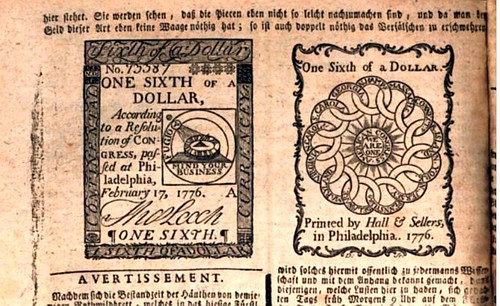
Erik Goldstein, Senior Curator of Mechanical Arts & Numismatics at The Colonial Williamsburg Foundation writes:
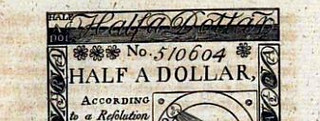 "This find from Julia Casey is very interesting. What does it say that a 17 Feb 1776 $1/2 bill, serial numbered towards the end of the 600,000 sequence, existed in time to make it to Germany for publication in 1777? Could this suggest that all 600,000 bills of each of the four denominations were printed, signed and released into circulation very soon after the date authorizing their issue? Pretty cool and significant."
"This find from Julia Casey is very interesting. What does it say that a 17 Feb 1776 $1/2 bill, serial numbered towards the end of the 600,000 sequence, existed in time to make it to Germany for publication in 1777? Could this suggest that all 600,000 bills of each of the four denominations were printed, signed and released into circulation very soon after the date authorizing their issue? Pretty cool and significant."
Interesting observation. But without specific contemporary documentation we may never know in what order the numbered notes were dispersed. If the entire print run was immediately numbered and signed, perhaps the last notes printed ended up at the top of the pile, making the higher-numbered ones among the first to be circulated. -Editor
Erik adds:
"I think it was/is commonly believed that these 17 Feb 76 fractional notes, issued in huge numbers, were printed & signed over many months, if not a few years (at least until inflation exploded). I recall Joe Lasser telling me that some of the signatories he’d seen on them weren’t authorized by Congress to sign the bills until much later than the date of issue."
Julia Casey writes:
"Many thanks to all who replied! I greatly appreciate the assistance and comments."
Thanks, everyone! These are interesting discoveries, and who knows what other gems are waiting to be found as more and more publications get digitized and made available to researchers. -Editor
To read the earlier E-Sylum article, see:
1777 GERMAN ILLUSTRATIONS OF COLONIAL PAPER
(https://www.coinbooks.org/v24/esylum_v24n12a11.html)
THE BOOK BAZARRE
THE NEW YORK WORLD'S FAIR MEDAL PROCESS SET
"As to the 1964 NYWF medal, may I direct you to The MCA Advisory?
"New York City - A Tercentennial of Medals; The MCA Advisory, Quarterly Journal of The Medal Collectors of America Vol. 23, Nos. 1&2, Medal Collectors of America, Boston, MA March/June Issue, Spring/Summer 2020 pp57-58." "Additionally I have attached the little leaflet that accompanied each boxed medal. While there is no mention of process series for sale, process was on the mind of the leaflet writer as he went into it in some detail."
Harry also included links to Dick Johnson's databank entry on Anthony de Francisci, the medal's designer, and an earlier E-Sylum article on the topic. Thanks! -Editor
Harry adds:
"Dick Johnson’s entry for de Francisci catalogs at least 6 different reverses for the medal. All are pictured.
"While I have never seen a process set for this medal something keeps nagging at me that there is a reference to one that I have read but, alas, alack, the memory has faded."
To read Dick Johnson's article, see:
de FRANCISCI, Anthony (1887-1964) Italian-American sculptor, medalist.
(http://www.medalartists.com/de-francisci-anthony.html)
To read the earlier E-Sylum article, see:
THE LIFE AND WORK OF ANTHONY DE FRANCISCI
(https://www.coinbooks.org/esylum_v17n06a16.html)
George Cuhaj writes:
"Process sets were sometimes offered to a client as a "special order" item as someone involved in the group was probably a collector, other times, process sets are made of special medals by the company as salesman's samples.
"This New York World's Fair set was probably done as I am sure Medallic Art Co. was pleased to win the contract to strike these medals. If they were for internal use and display than they were made for free and probably without the knowledge of the NYWF Commission. If they were made for the NYWF Commission, than Medallic Art Co. would charge for them (just as if they were finished medals.) In the 1980s when I (and others) were involved with the Metropolitan New York Numismatic Convention the medals committee always offered the annual medals made in conjunction with various annual host clubs process sets by subscription.
"Joe Levine of Presidential Coin & Antique Co. who served on several Presidential Inaugural committees often had a very limited and controlled process strike sets made encased in a Lucite block for display. Some have made auction appearances.
"The Black Sharpie was most certainly done at a later date, as the marker was only launched in 1964, it is very possible that these process set strikes were also done at a later date and not in 1964. Now that the Medallic Art Company records have come onto the market, the knowledge of after strikes for "record" purposes have come to light (that is another issue for another day).
"We see from this process set that Medallic Art Co. used a non-collared die striking process and the extra metal was trimmed off by a lathe before applying a patina.
"The value in this case is to a NY City or a World's Fair collector."
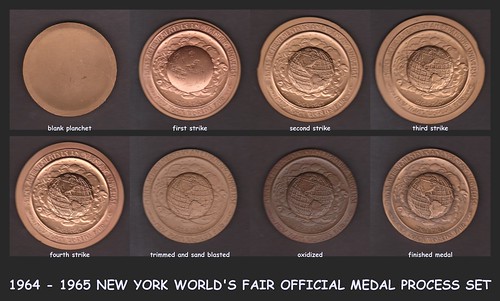
Matt Hansen of Lincoln, Nebraska writes:
"I wanted to respond to the questions regarding the 1964-1965 New York World’s Fair medal process set from Medallic Art Company. Although I can’t offer much of any information specific to the origins of the New York World's Fair set, I do know that a very similar "process set" of medals (that also included a blank planchet as well as a piece of the bronze planchet strip) were produced by Medallic Art Company for the striking of the 1967 Nebraska Centennial medal. Striking of the medals took place at Medallic Art Co. in 1966.
"John J. Garrarron (former librarian of the ANA, and long-serving Sergeant-at-Arms at ANA Annual Conventions from 1961 until 1997) of Lincoln, Nebraska, as appointed chairman of the Nebraska Centennial Medal Committee by the Nebraska Centennial Commission, and helped coordinate distribution and sales of the 1967 Nebraska Centennial medals. This process set was among the items in Mr. Gabarron's estate at the time of his death in 2001, and was acquired by my friend, fellow collector, and Nebraska Centennial medal enthusiast, John Veach.
"John has exhibited the process set (see attached image) at different events, and it is highly educational for showing the multi-step process that went into the manufacture of these spectacular medals. I don't know if these "process sets" were something that Medallic Art Company produced for each and every medal they were commissioned to strike, but there are at least two examples now known of it having been done."
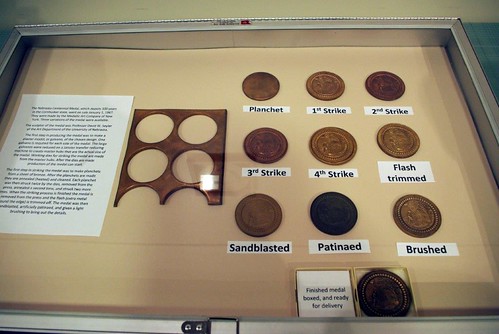
1967 Nebraska Centennial medal process set exhibit
Thanks, everyone! -Editor
To read the earlier E-Sylum article, see:
NEW YORK WORLD'S FAIR MEDAL PROCESS SET
(https://www.coinbooks.org/v24/esylum_v24n12a14.html)

NOTES FROM E-SYLUM READERS: MARCH 28, 2021
Neziah Wright PaintingPete Smith writes:
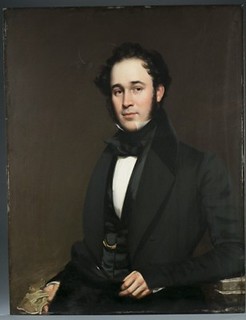 "On September 16. 2016, Quinn’s Auction Galleries of Chadds Ford, Virginia, sold a “Portrait of an Unknown Gentleman” as lot 144. The painting was done in 1834 by the firm of Samuel Waldo and William Jewett. The painting, done in oil on board, is 36 x 28 inches with the Waldo and Jewett stencil on the back.
"On September 16. 2016, Quinn’s Auction Galleries of Chadds Ford, Virginia, sold a “Portrait of an Unknown Gentleman” as lot 144. The painting was done in 1834 by the firm of Samuel Waldo and William Jewett. The painting, done in oil on board, is 36 x 28 inches with the Waldo and Jewett stencil on the back.
"After the sale, the buyer was told that it is a portrait of Neziah Wright. He was born in Lyman, New Hampshire, on August 10, 1804, the son of Lockhart and Abigail Bliss Wright. He was married to Lauretta with a daughter. He died in Manhattan on February 25, 1879.
"The painting shows him, not as an engraver and tradesman, but rather as a gentleman and partner in the successful firm of Rawdon, Wright, Hatch and Edson."
Thanks. Great portrait. So far, no one has been able to answer Pete's earlier questions - a) who previously owned the painting? and b) are there any other known portraits of Neziah Wright? Can anyone help? -Editor
To read the earlier E-Sylum article, see:
NOTES FROM E-SYLUM READERS: MARCH 21, 2021 : Seeking Picture of Neziah Wright
(https://www.coinbooks.org/v24/club_nbs_esylum_v24n12.html)
Jan Monroe writes:
"I am trying to find out what company minted these medals. They were issued in sets and put in die-cut cardboard holders with stamped lettering on the cardboard. The unknown to me company made these for many different locations. The style is the same with low relief nickel silver medals and silver medals. The cardboard was housed in a plastic sleeve. If anyone who reads The E-Sylum can help I would appreciate it. "
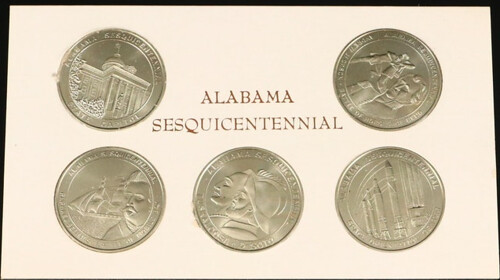
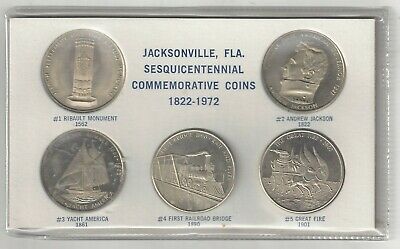
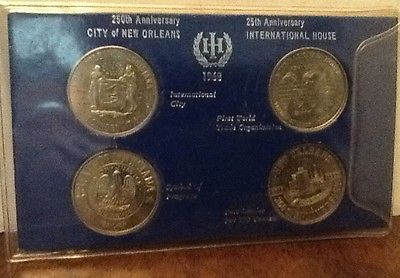
Can anyone help? -Editor
Gerry Tebben writes:
"There's a curious mention of coin dealing in the mid-1950s in Saturday's Wall Street Journal. The obituary for Chicago fund manager Richard Driehaus notes: Around age 12, he began collecting coins and soon discovered he could make money selling some of them. Having noticed coin dealers’ display ads in a numismatic magazine, he scoured smaller notices at the back of the publication “to see what they were actually trying to buy for their own accounts, rather than what they wanted to unload on the public,” he said. “Then I would shadow them.”
"Given the year, my bet would be he was reading Numismatic Scrapbook."
Thanks - I saw the article. It said that "By the time he graduated from high school, ... he had about $2,000 (the current equivalent of nearly $18,000) in cash savings and $3,000 to $4,000 of coins." I searched the Newman Numismatic Portal for his name, and only got hits in Coin World in 1964, likely in his classified ads. I haven't seen Richard Driehaus mentioned elsewhere as a collector. Or was he a secretive buyer? Will there be a Driehaus collection sale in the future? -Editor
To read the complete article (subscription required), see:
Richard Driehaus, Stock-Market Daredevil, Preserved Traditional Architecture
(https://www.wsj.com/articles/richard-driehaus-stock-market-daredevil-preserved-traditional-architecture-11616673753)
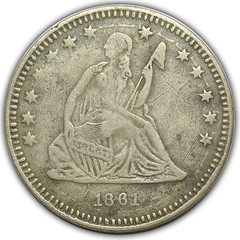
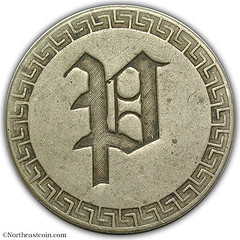
Tom Caldwell of Northeast Numismatics writes:
"Here’s a Seated quarter love token of sorts with a “p” initial and as is often the case another initial that we are not certain what it is as the engraver got creative. Of course Seated dimes are most common for this popularly collected area. All other denominations are slightly scarce to fairly scarce. Besides this being a quarter another fact sticks out - this is a counterfeit. Appears to be German silver but not certain. Looking at the seam on the reverse in rim area we are guessing it was “minted” with a blank reverse as opposed to having been shaved which is the typical case on traditional love tokens."
Anne Bentley passed along this tweet by London Mudlark Lara Maiklem. Thanks. Neat coin. -Editor
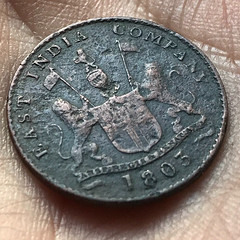
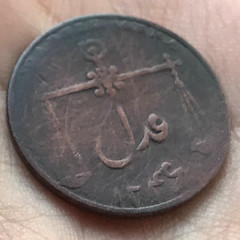
East India Company cash coin (1803) found on the Thames near to the docks used by the East India ships. The value is written in Persian: Dah kas do falus ast: 10 cash is equal to one dudu; there were 8 dudus in a fanam and 42 fanams in a pagoda.
To read the complete tweet, see:
https://twitter.com/LondonMudlark/status/1373184518908182528
Regarding the name of the new Düsseldorf-based coin auction firm Gut-Lynt, Max Hensley writes:
"I ran this name through Google translate and it came out Belly Button Bunny. Ha ha."
To read the earlier E-Sylum article, see:
MUENZEN GUT-LYNT ONLINE AUCTIONS
(https://www.coinbooks.org/v24/esylum_v24n11a23.html)
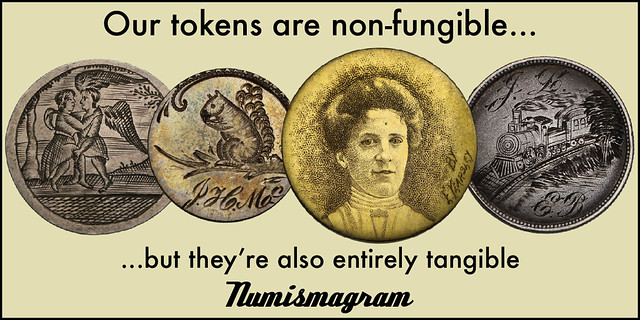
THE LOUVRE COLLECTION ONLINE
Scott Miller passed along this CNN article about the new online galleries from the Louvre museum. Thanks. -Editor
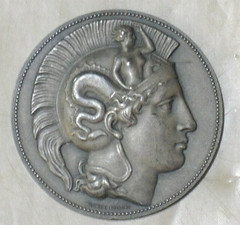 There is nothing like spending a rainy afternoon at a museum, soaking in the beauty and wonder of art and history. Now the Louvre, the world's most visited museum, is letting you do that right from home.
There is nothing like spending a rainy afternoon at a museum, soaking in the beauty and wonder of art and history. Now the Louvre, the world's most visited museum, is letting you do that right from home.
The French museum has released an online platform featuring all of the museum's artworks, consisting of more than 480,000 pieces, the Louvre announced Friday in a press release.
Art lovers and researchers alike will now be able to view the entire Louvre collection online for free.
"Today, the Louvre is dusting off its treasures, even the least-known," Jean-Luc Martinez, the president and director of the Louvre, said in a statement. "For the first time, anyone can access the entire collection of works from a computer or smartphone for free, whether they are on display in the museum, on loan, even long-term, or in storage."
To read the complete article, see:
Miss art museums? The Louvre just put its entire art collection online
(https://www.cnn.com/style/article/louvre-art-collection-free-museum-trnd/index.html)
So, what numismatic treasures await? I came up empty until I first translated some search terms into French. A search for "coin medal" (médaille de monnaie) brought back about five thousand records. The Louvre certainly isn't known for their numismatic collection, but it might be worth exploring the catalog for your own areas of interest. -Editor
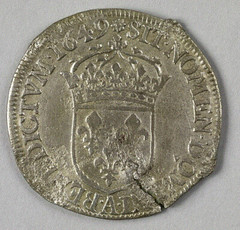
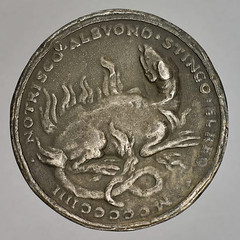
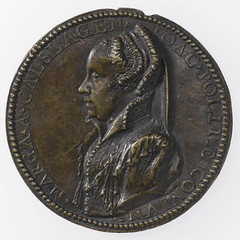
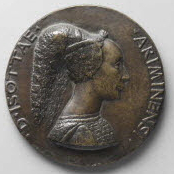
To read the complete article, see:
Miss art museums? The Louvre just put its entire art collection online
(https://www.cnn.com/style/article/louvre-art-collection-free-museum-trnd/index.html)
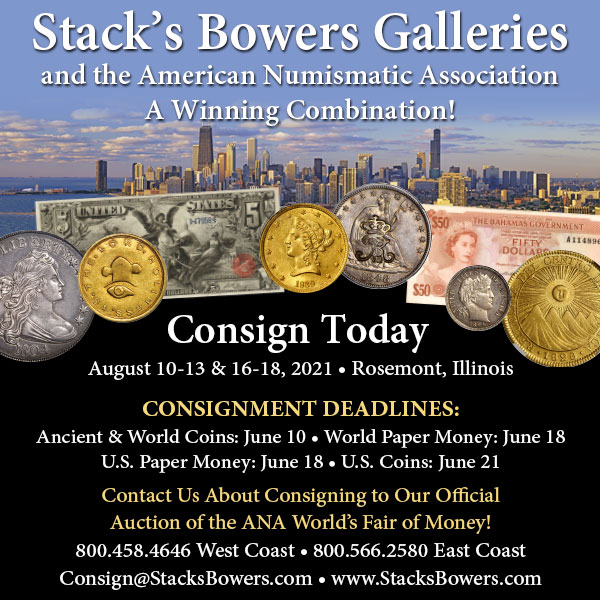
VOCABULARY TERM: CLAD, CLADDING
Here's another entry from Dick Johnson's Encyclopedia of Coin and Medal Terminology. -Editor
Clad, Cladding. Bonding together thin layers of metal of differing alloys to form a sandwich construction. Technically the outer or exposed layers are termed the clad layer, or lamina, the internal layer is the core. This is done in every instance for the physical characteristics of the outer or clad composition, as for the color, hardness, appearance, and electric sensitivity of this surface. The use of the core is generally one of lower cost than the clad metal. The line separating the core from the clad metal, called the boundry, it can be observed on the edge of U.S. coins minted after 1965 (but not those of some European coins, as Sweden, where upsetting is designed to cover the core on the edge).
Medals were first clad as early as 1789. In that year Barton's metal was used for the George III Recovery Medal by J.P. Droz (Brown 311) struck at Matthew Boulton's factory. Barton's metal was formed by rolling strips of silver (or gold) on a copper core with adhesion by fusion.
In 1964 the United States enacted a coinage law that required U.S. coins to be made of clad metal. Faced with a drastic coin shortage, a world-wide silver shortage and rising metal prices, the Treasury Department chose to turn to a copper nickel clad metal over a copper core for all former silver coins, dimes, quarters and half dollars.
This was a brilliant solution. Not only did it meet all the criteria of a circulating coin composition (including the demanding needs of the vending machine industry) but also considered the metal salvage of this composition. Skeleton scrap of this clad composition could be melted and easily reformulated back into a copper nickel formulation.
How clad strip is made. Ingots of the correct composition are rolled repeatedly to a thickness several times the thickness of the intended coin. They are metal cleaned by pickling. The layers are then placed in a rolling mill in proper sequence, the core between the two outer layers. They can be roll bonded if the metal strips are heated, then rolling is done under heat and pressure. If they are cold rolled they can be bonded by explosion bonding. The strips are then successively rolled until the required thickness is obtained.
Since January 1994 clad strips of copper nickel lamina on copper core are supplied to the United States Mints (Philadelphia and Denver) by PMX Industries, Cedar Rapids, Iowa, which uses the roll bonded method. Each strip weights between 3,000 and 7,000 pounds and are approximately 1,000 feet long.
The strip must be manufactured within a permitted tolerance of .0015-inch (.038mm) thickness for clad strip of any denomination.
The mints blank the strips and return the skeleton scrap strips to the supplier. The supplier repossesses the scrap by adding fresh nickel to the formulation to the correct formula (75% copper 25% nickel) for new copper nickel clad layers.
The mints blank about 75% of the strip (73% at Philadelphia Mint) and return the balance. The blanks are upset by upsetting machines then struck in coining presses within the mint.
More recently, the U.S. Mint has been contracting the blanking to private industry as well as the formulation and rolling. Thus economies are achieved by not having to ship the skeleton scrap for reprocessing. The mint receives blanks for upsetting and striking within the mint.
Clad coinage characteristics. When clad blanks are struck, particularly during coining, the surface displacement comes only from the outer lamina on each side. The inner core is unaffected. On solid blanks metal is drawn from deep within the blank in addition to surface movement into the die cavities. The boundary on clad blanks literally acts as an edge beyond which no metal flow occurs in the core. This is quite evident when the lamina becomes separated from the core. To a degree, clad compositions effectively eliminate suction or ghosting in struck pieces.
Clad anomalies. Potential for a new group of errors occurred once a clad composition was chosen for national coinage. The debonding of the clad lamina layer, created a new class of lamination errors. One anomaly can occur before the coin is struck – causing a lightweight blank and very poor detail – or another after the coin is struck, with clad metal sometimes still in place, more often separated. The separating of the clad layer is called peeling.
Should the separated lamina flake off and fall onto another blank while in the coining press it could be impressed into another coin; often this is a letter (from the high stress area of the legend) and is called a dropped letter. If the flake is still attached to the coin it is called a clamshell by collectors, the point where it is still attached is called the hinge.
Reference:
B12 {1969} Young.
CH82 {1998} Doty, p 36 (Barton's metal).
To read the complete entry on the Newman Numismatic Portal, see:
https://nnp.wustl.edu/library/dictionarydetail/515490
(https://nnp.wustl.edu/library/dictionarydetail/515490)
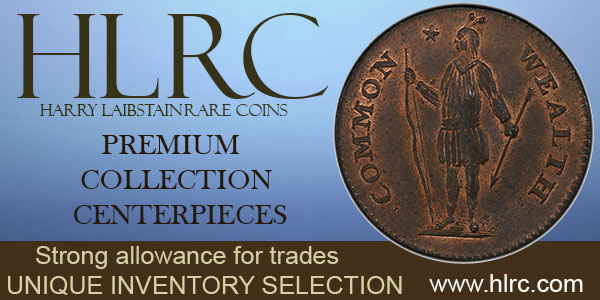
HARRY JASON LELANDE (1871-1965)
Here's another entry from the online draft of John Lupia's book of numismatic biographies. Thanks! This is an excerpt with the full article and bibliography available online. This week's subject is collector and ANA member Harry J. Lelande. -Editor
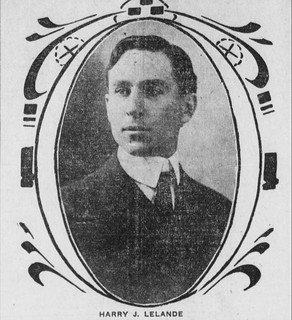 Lelande, Harry Jason (1871-1965), in 1911: 257 South Spring, Los Angeles, Room 22 Court House, Los Angeles, California.
Lelande, Harry Jason (1871-1965), in 1911: 257 South Spring, Los Angeles, Room 22 Court House, Los Angeles, California.
He was born October 28, 1871 in Sonora, California, son of Peter Jason Lelande and Adele St. Cyr Leland.
Education:
He attended Los Angeles public schools from 1877-1885. He studied at St. Vincent’s College 1885-1886 and matriculated into Phillips’ Academy, Andover, Massachusetts 1887-1888. He then studied at Sheffield Scientific Department at Yale University in 1889. He returned to California and began studying at Santa Clara College 1889-1890.
He began his career as a clerk from 1890-1892 with the firm of Edwards & McKnight, booksellers and stationers 114 West First Street, Los Angeles. He purchased McKnight’s interest in the firm in 1892 and the firm was renamed Wm. M. Edwards Co. In 1894, he bought out Edwards and sold the business to Whedon & Webb Co. in 1895.
He entered into the fire insurance industry with Victor Wankowski from 1896-1897, and went into business alone in 1898. He entered into Los Angeles municipal government as an assistant assessor under Ben E. Ward 1899-1900. He became the correspondence clerk for W. A. White, the City Tax Collector from 1901-1902. He was elected City Clerk of Los Angeles in December 1902. He reigned in 1910 to take the office of the County Clerk in January 1911. He resigned in May 1919 during the De Leonis case investigation. He was the Director of the Banker's Loan Guarantee Company. Director and Treasurer of the Grizzly Bear Publishing Company. Director of the American Machine Tool Company. Director of Gates Oil Company. He died September 1965 at age 93.
Hobbies:
He was an avid collector of stamps, coins and was a naturalist and amateur ornithologist. He was a member of the American Philatelic Society. He was president of the Cooper Ornithological Club; a member of the Union League; and the Los Angeles Athletics Club. Secretary of the Vernon Athletic Association. In 1910 he was president of the Los Angeles Athletics baseball team. Hollenbeck Lodge of Masons, Elks Lodge No. 99.
Numismatic Career:
He was member no. 1523 of the ANA since October 1911. On September 20, 1928 he held a coin auction of the Alonso Paige Lansing collection listed in Martin Gengerke. Of special notice he purchased William Poillon’s copy of Numisgraphics. Lelande’s copy was purchased by Charles Chopnick (1907-2005), who had it bound by Arthur Rahm Bookbinding, Colorado Springs, Colorado. Chopnick was an optical manufacturer and president of Pacific Universal Products in Pasadena, California. Lelande's copy of Numisgraphics is now in the American Numismatic Association Library.
Work:
Catalogue of the Collection of Coins of Alonso Paige Lansing to be sold at auction September 20, 1928, Los Angeles, California.
To read the complete article, see:
LELANDE, HARRY JASON
(http://www.numismaticmall.com/numismaticmall-com/lelande-harry-jason)
HARVEY STACK'S NUMISMATIC FAMILY, PART 92
The latest article in Harvey Stack's blog series discusses the opening of a new era in the coin business following the silver boom and bust of the early 1980s. Thanks! -Editor
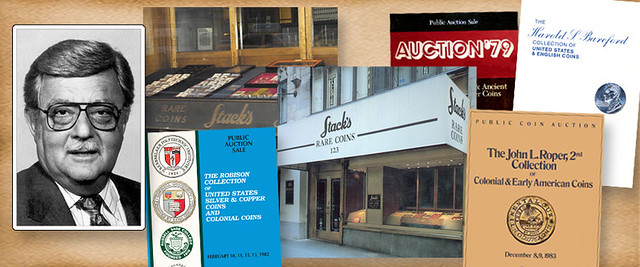
The year of 1984 showed continued growth of interest in numismatics. Serious collectors returned to the hobby, just when some major collections were being marketed, providing a wonderful opportunity for buyers. The availability of coins that had resided in many old timer collections stimulated a rise in coin values that continued to recover from the damage done by the run up and crash of the silver market a few years earlier. While the first few years of the 1980s had been a little slow, the market by the end of 1983 showed that there did not seem to be a long term effect on coin collecting, especially for more traditional hobbyists.
As mentioned earlier, there was also movement in the industry to reduce the detrimental effects of counterfeit and doctored coins. Many of those who tried to deal in these items were detected and revealed, increasing confidence in professional dealers of good standing. The ANA and the PNG both took steps to assist with this. The PNG grew in numbers and maintained strict enforcement of the hobby. In 1984 I was a member of the Board of PNG and we worked tirelessly to regain and retain the appreciation of collectors for the reliability of numismatic professionals. The ANA started to examine all advertising in the Numismatist and stopped accepting misleading, false and improper ads. Trade publications such as Coin World, Numismatic News and others followed, and confidence quickly returned to the marketplace.
During this year, Stack's was awarded a number of old-timer collections to offer at public auction, either by owners or estates, and we produced 12 public auction catalogs in 1984. Some of the name collections featured in these sales were Amon Carter, John L. Roper, John Halsell, Fredrick Knobloch, Floyd T. Starr, T. Bergin, Geo. Kosko, Yale University, Bartle Family, and Richard Picker, a phenomenal group for just one year. It was an exciting year for the hobby and for the Stack's organization. Along with myself, Norman, and Larry, we had a remarkable staff that helped us achieve the record breaking year we enjoyed.
Our over-the-counter business, as well as mail orders were strong, and we were able help new collectors develop and expand their collections. We worked hard to maintain our leadership in the hobby. Our senior staff, including myself, traveled all over the country, to attend numerous trade shows and visit coin clubs. The American Numismatic Association grew in membership as did the number of clubs affiliated with the national organization. Newspapers and magazines around the country started coin collecting pages and carried articles and advertisements.
Stack's was well known throughout the numismatic community, and we were often called upon to make appraisals. We worked directly with banks and trust companies and even served as advisors to some that were overseas. Notable among these were overseas banks that had in their vaults large holdings of United States $20 gold double eagles (as described in an earlier chapter). There was a lot of activity and all of us worked many hours to maintain our place in the hobby.
On top of all this, 1984 was a landmark year for auction sales, led off by our January offering of the Amon G. Carter, Jr. Collection of Gold Coins, which will be the feature of my next article.?
To read the complete article, see:
Harvey Stack Remembers Growing up in a Numismatic Family, Part 92
(https://www.stacksbowers.com/News/Pages/Blogs.aspx?ArticleID=Harvey-Stack-Remembers-92)
To read the earlier E-Sylum article, see:
HARVEY STACK'S NUMISMATIC FAMILY, PART 91
(https://www.coinbooks.org/v24/esylum_v24n11a19.html)

FUND DRIVE: GET ABE & BEN TO ROSEMONT
Readers: please consider contributing something to this fundraiser for numismatic education efforts at this year's ANA World's Fair of Money in Rosemont. Here's the press release. -Editor
Get Abe Lincoln & Ben Franklin to Rosemont
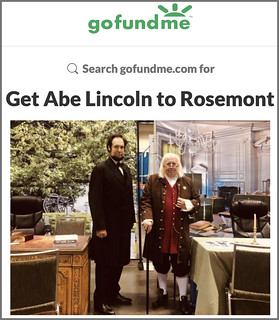 The Pennsylvania Association of Numismatists and PAN Secretary, Patrick McBride (Benjamin Franklin re-enactor) have created a GoFundMe page to raise money to bring renowned Abraham Lincoln actor, Dennis Boggs, to the American Numismatic Association’s World’s Fair of Money to be held at the Stephens Convention Center, in Rosemont (Chicago), IL on August 10 – 14, 2021. The money generated will cover Dennis’ fee, airfare, hotel stay, etc. This fund drive was originally created for the 2020 Pittsburgh ANA-WFM that was canceled due to Covid-19. The money raised was rolled over to this new “Get Abe to Rosemont” fund drive. Between GoFundMe and private donations, we have raised $1,900. Our goal this time is to raise more than $4,000 so that we can also help old Ben Franklin to get to Rosemont.
The Pennsylvania Association of Numismatists and PAN Secretary, Patrick McBride (Benjamin Franklin re-enactor) have created a GoFundMe page to raise money to bring renowned Abraham Lincoln actor, Dennis Boggs, to the American Numismatic Association’s World’s Fair of Money to be held at the Stephens Convention Center, in Rosemont (Chicago), IL on August 10 – 14, 2021. The money generated will cover Dennis’ fee, airfare, hotel stay, etc. This fund drive was originally created for the 2020 Pittsburgh ANA-WFM that was canceled due to Covid-19. The money raised was rolled over to this new “Get Abe to Rosemont” fund drive. Between GoFundMe and private donations, we have raised $1,900. Our goal this time is to raise more than $4,000 so that we can also help old Ben Franklin to get to Rosemont.
Lincoln and Franklin have appeared together previously charming the young and old alike with their wit, humor and historical tales. They have together attended the Florida United Numismatists (FUN) convention in January of 2020 and the last ANA World’s Fair of Money, Chicago IL, in August of 2019. Many dealers, vendors, and attendees enjoyed posing for photos with these grand historical figures, but most importantly, the children whose eyes lit up and tongues tied in the presence of Mr. Lincoln www.MeetMrLincoln.com or Dr. Franklin www.FranklinAlive.com was priceless. Imagine being 10 years old and able to tell your teacher that you met President Lincoln or Dr. Franklin or BOTH! What is a more wonderful gift than giving to our children the desire to learn through living history? Young collectors are the future of the coin business, and we encourage you make a donation.
Small amounts are encouraged. Ten dollars each from 200 donors will easily reach our goal. Please consider a $5 Lincoln note or a $100 Franklin note to get these engaging characters to Rosemont this summer. Mailed donations are also gladly accepted. All monies are deposited into our PAN Foundation 501(c)(3) account and are tax deductible. Make checks payable to:
PAN 1985 Lincoln Way Suite 23 #225 White Oak PA 15131
The Internet web GoFundMe platform is popular and easy to use. The platform will encourage donors to leave a tip that will go to sustain the platform service. You are able to tip zero money if you choose or any dollar amount other than the 10% the GoFundMe platform suggests. To donate go to: https://gofund.me/b2fad787 or to the PAN website home page www.PANcoins.org and click the photo.
To read the earlier E-Sylum article, see:
FUND DRIVE: GET MR. LINCOLN TO THE PITTSBURGH ANA
(https://www.coinbooks.org/v23/esylum_v23n09a20.html)
SAN DIEGO SPEAKERS KORCHNAK AND FANNING
San Diego Numismatic Society President Greg Knox passed along this announcement of two upcoming presentations that may be of interest to E-Sylum readers. Thanks! -Editor
On Tuesday, April 6th, at 6pm PDT, ANA member Dr. Lawrence Korchnak will speak to SDNS about siege coins and his new book: Obsidional Coins of the World, 1453 – 1902, being published this summer by CNG. Larry’s talk can be accessed by the link: https://global.gotomeeting.com/join/459647541 .
On Tuesday, May 4th, at 6pm PDT, David Fanning of numismatic book dealers Kolbe & Fanning will speak on books, auctions, and numismatics – title TBA. To access this site via GoToMeeting, please use: https://global.gotomeeting.com/join/205907757 .
There is no charge for the talks, membership is not required, and all who have an interest in numismatics are welcome!
Mark your calendars! I just did. Remember, these are Pacific times - 6pm PDT will be 9pm EDT (Eastern Daylight Time) for those of us in the Eastern U.S. -Editor

RESEARCH USING IMAGING AND GOOGLE TRANSLATE
Franky Leeuwerck's Scripophily blog has an interesting article about combining scanning, Google Translate and a cellphone camera to do some numismatic research. Very clever! -Editor
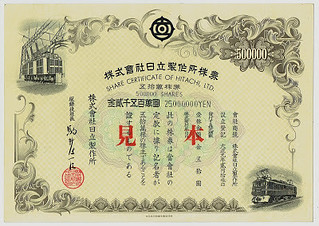 There is always a possibility that one can't detect a printer name on a certificate. The reason why may be simple. Sometimes the design did not include a printer name. Or, speaking for myself in this case, the name can not be identified because you don't know how to read the language.
There is always a possibility that one can't detect a printer name on a certificate. The reason why may be simple. Sometimes the design did not include a printer name. Or, speaking for myself in this case, the name can not be identified because you don't know how to read the language.
The illustrated Hitachi share shows the name of its printer at the bottom. It's in Japanese. That's out of my depth but there is a work-around.
I once wrote about What you can do with Google Translate on your smartphone. In that article, I showed you how to deal with scripophily catalogs in an unknown language. I tried that same approach, this time on the printer name of the Hitachi share. It did not work.
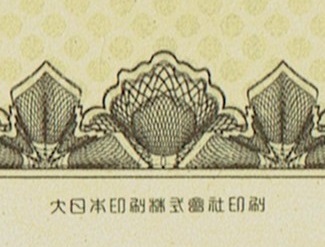
The name of printer was too small, less than 2cm, about two grains of rice long. The characters, less than 1.5 mm wide, were too small for my camera to be recognized. If I could only provide a larger image. Now, that thought turned out to be a step in the right direction.

I put the certificate on the image scanner. I set the scanning properties to a high resolution of 600 dots per inch to get a large and clear image of that line of text. I narrowed the scan area to a rectangle surrounding the text. The resulting image, see above, was saved.
Next, I opened the saved image file on the PC screen, and started the Google Translate app on the smartphone.
I pointed the camera to the image on the PC screen and pressed the camera icon in the app.
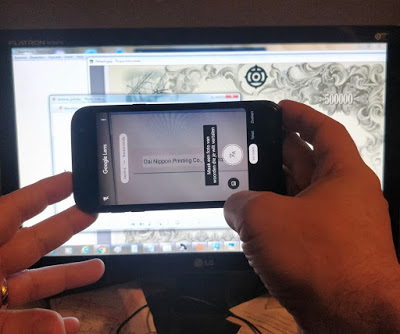
The Google Translate software tried to recognize the words that were captured by the camera. It was necessary to find the right distance between the camera and the computer screen by holding the phone closer to and further from the screen. Then the answer appeared on the phone : Dai Nippon Printing Co., Ltd. Got it !
To read the complete article, see:
Google Translate and tiny printer names
(http://leeuwerck.blogspot.com/2021/03/google-translate-and-tiny-printer-names.html)

ANS COIN PHOTOGRAPHY TIPS
Check out the American Numismatic Society's Pocket Change blog for another useful set of tech tips, this time for photographing coins for sale on eBay. Here's an excerpt from the article by John Thomassen. -Editor
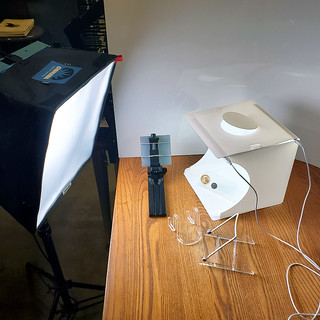 As the ANS continues to make duplicates from its collection available on eBay, it may be of interest to Society members and eBay browsers alike to learn how our listings are photographed, as this is one of several important steps in ensuring that objects offered on eBay are described accurately. Detailed text descriptions are of course important, but in our current digital age, many buyers immediately gravitate towards listings with consistent, high-quality photos. This is true for both eBay and almost any other online auction platform.
As the ANS continues to make duplicates from its collection available on eBay, it may be of interest to Society members and eBay browsers alike to learn how our listings are photographed, as this is one of several important steps in ensuring that objects offered on eBay are described accurately. Detailed text descriptions are of course important, but in our current digital age, many buyers immediately gravitate towards listings with consistent, high-quality photos. This is true for both eBay and almost any other online auction platform.
While the photographic process associated with cataloging the American Numismatic Society’s various holdings is more rigorous and precise than what is required for eBay, the steps for both are generally similar. Once the individual objects and lots have been selected, they are taken to an area separate from the equipment used to photograph collection objects. This photography setup is comparatively low-tech, and relies on an LED light box, a larger professional studio light, a tripod, and staging platforms and props where individual objects and lots can be quickly arranged, photographed, and placed back into protective flips, archival bags, and tubes. The setup is a balance between speed and efficiency coupled with taking sharp, clear, and well-lit photos that require minimal editing.
Because speed and efficiency are critical, photos are taken on an ordinary smartphone so that images can be wirelessly transferred to a computer workstation for editing immediately after photos are taken. Likewise, care is taken to ensure that each shot has the proper lighting (both intensity and color) best suited to the objects being photographed, are angled correctly to catch the light and accurately highlight the objects’ surfaces, are clear and sharp by way of a steady tripod adapted to hold a smartphone, and are photographed at a distance proportional to the size of the object.
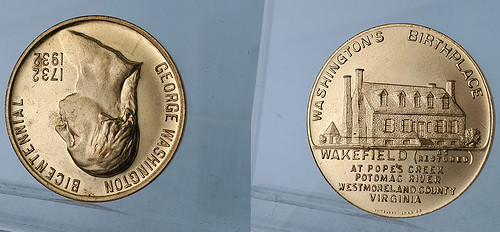
Once photos have been taken and all objects are safely stored away, the files can be wirelessly transferred to a computer workstation, where they are edited in a computer program to be more presentable on eBay. Editing is a crucial step, but also one where overzealous editing is discouraged. Photos destined for eBay undergo two steps: rotating the object to ensure correct orientation, and replacing the background with a neutral gradient.
You may have noticed that in the above photos, the obverse of the George Washington medal was completely upside down; this was not a mistake, but rather a move to ensure that any shadows appeared at the rear of Washington’s head, and not along his face. After the objects have been rotated, the background is removed, and a neutral gradient is added to avoid the stark contrast of a pure white background.
To read the complete article, see:
ANS EBAY STORE BEHIND-THE-SCENES: COIN PHOTOGRAPHY
(http://numismatics.org/pocketchange/ebay-photos/)

RECORD PRICE FOR 1822 HALF EAGLE
We don't typically cover the topics of grading and pricing, but there was a notable event this week with the Stack's Bowers sale of the Pogue 1822 Half Eagle. Plus I feel bad that I was unable to find time to pull together a preview article for the sale last week. Anyway, here's the press release. -Editor
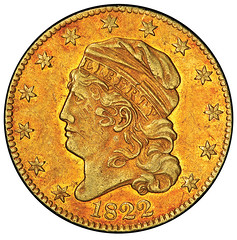
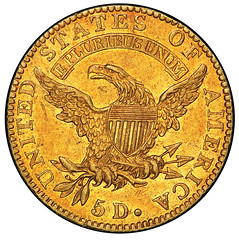
The finest known 1822 half eagle sold for $8.4 million in the Stack’s Bowers Galleries March 2021 Las Vegas Auction, setting a new world record in the process. Graded AU-50 by PCGS, this historic $5 coin from the D. Brent Pogue Collection was offered March 25 in the firm’s Rarities Night session. It is now the most valuable U.S. Mint gold coin that has ever sold at auction, and has surpassed even the highest prices paid for a 1913 Liberty nickel, 1804 silver dollar, or 1933 double eagle.
The 1822 half eagle is a legendary American treasure and represents the lynchpin to a complete set of U.S. coinage. There are only three known specimens, two of which are permanently impounded in the National Numismatic Collection in the Smithsonian Institution. The Pogue-Eliasberg specimen sold by Stack’s Bowers Galleries is the only example in private hands and represents a unique opportunity to own this issue. Most of the great figures in American numismatics never possessed one, and many have been born and died without ever having had the chance to compete for one at auction.
Prior to the Stack’s Bowers Galleries sale, there had been only two occasions in American numismatic history in which an 1822 half eagle has sold at auction: the 1906 Harlan P. Smith Collection Sale and Stack’s Bowers Galleries’ 1982 sale of the Louis E. Eliasberg Gold Coin Collection. The Smith specimen was later donated with the Lilly Collection of gold coins to the Smithsonian Institution. The other Smithsonian example is traced to the Mint Cabinet Collection, where it had been since the 1830s.
The About Uncirculated Pogue Specimen was first acquired by Virgil Brand in 1899 and held in his vast collection until sold by his heirs in 1945. At that time it entered the unparalleled cabinet of Louis E. Eliasberg, Sr., and became part of the only complete collection of U.S. coins ever formed. When the gold coins from the Eliasberg Collection were auctioned in 1982, the successful buyer was the young D. Brent Pogue in the early stages of building what would become the most valuable numismatic collection in history, a cabinet which has realized over $140 million in a series of sales by Stack’s Bowers Galleries from 2015 through 2021.
With a price realized of $8.4 million, the Pogue 1822 half eagle now takes pride of place in a new cabinet. It had been in only three collections over more than 115 years, and now a fourth collector has added their name to this exclusive roster. Generations may pass before even the most well-financed collectors, dealers, and museums have another opportunity to own this issue. For more information on this historic offering or to consign your collection to auction, visit StacksBowers.com or call 800-458-4646 to speak with a numismatic specialist.
High prices get attention, and hopefully this story will travel in the mainstream media at least as fast and far as this week's story about the pile of oily revenge pennies in Georgia. Barron's and ABC News were among the first to pick this up, with ABC reaching out to ANA Curator Douglas Mudd. -Editor
To read the complete article, see:
Historic $5 Gold Coin Sells for a Record $8.4 Million
(https://www.barrons.com/articles/historic-5-gold-coin-sells-for-a-record-8-4-million-01616796464)
Rare 1822 gold coin fetches record $8.4M at auction in Vegas
(https://abcnews.go.com/Entertainment/wireStory/rare-1822-gold-coin-fetches-record-84m-auction-76715912)

RECORD PRICE FOR 1797 HALF DOLLAR
Here's another notable sale of a rare and superbly pedigreed coin. -Editor
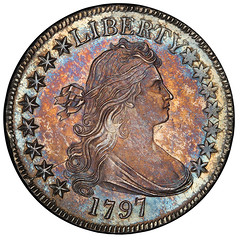
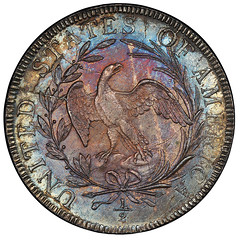
The finest known 1797 Draped Bust half dollar sold for $1.68 million in the Stack’s Bowers Galleries March 2021 Las Vegas Auction, setting a new record as the most valuable United States half dollar. Graded MS-66 by PCGS with provenance to the magnificent Pogue Collection, it was offered on March 25th in the firm’s Rarities Night session which will be remembered as an historic evening for American numismatics.
Produced for only two years in 1796 and 1797, the Draped Bust, Small Eagle half dollar is considered the rarest design type among American silver coinage. It is an incredible challenge at all grade levels and is typically encountered well-worn in Fine or Very Fine condition, often with surface problems. Fewer than 200 examples survive from the 1797 issue, only about 10 of which are in Mint State.
The Pogue specimen is considered the finest known from this exclusive group and has long been recognized as very significant. It is traced back to the legendary collection of Virgil Brand formed in the late 19 th and early 20th centuries. This record $1.68 million result represents only the third time this piece has sold at auction since it entered the Brand cabinet over 100 years ago – each of these three sales was conducted by Stack’s Bowers Galleries.
The Pogue 1797 half dollar was one of several records achieved in the Stack’s Bowers Galleries March 2021 sale, including an $8.4 million result for the finest known 1822 half eagle, also from the Pogue Collection, now the most valuable U.S. Mint gold coin.
With the success of the Stack’s Bowers Galleries March 2021 Las Vegas Auction, the firm is looking ahead to their June 2-4, 2021 Showcase Auction to be hosted in their new state-of-the-art headquarters and auction gallery in Costa Mesa, California. Consignments of U.S. coins, tokens and medals for the June auction are invited through April 8. For more information on the outstanding results from the March sale or to consign your collection to the Stack’s Bowers Galleries June 2021 Auction, visit StacksBowers.com or call 800-458-4646 to speak with a numismatic specialist.
Despite the seven-figure pricetag, this great coin likely won't get much media attention. But it's really great to see this activity at the high end of the market. What does this portend for the upcoming sale of the Farouk 1933 Double Eagle? Is another record price in the making?
There's also a YouTube video - check it out. -Editor
To watch the video, see:
The Magnificent Pogue 1797 Draped Bust Half Dollar in PCGS MS-66 CAC at Stack's Bowers Galleries
(https://www.youtube.com/watch?v=yDuKFabRjFw&list=PL-I65wvc5K3_ZnR8lBd8W008UH-BqMZ3m&index=255)
To read the earlier E-Sylum article, see:
FAROUK 1933 DOUBLE EAGLE RETURNS TO MARKET
(https://www.coinbooks.org/v24/esylum_v24n11a22.html)
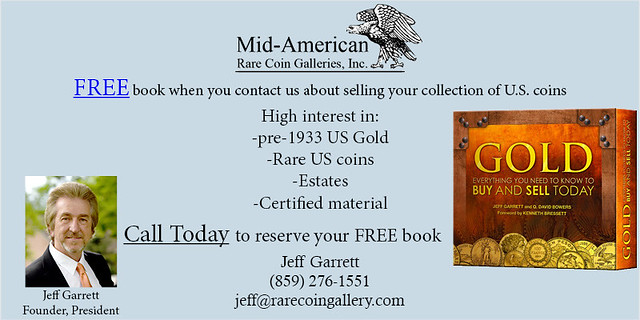
RECORD PRICE FOR 1937 EDWARD VIII 5 POUNDS
Heritage is setting records as well. Here's their press release on their sale of the 1937 Edward VIII 5 Pounds pattern. -Editor
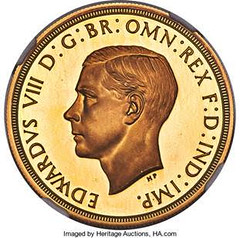
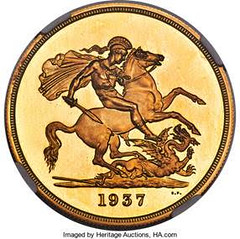
A 1937 Edward VIII 5 Pounds Pattern coin – one of only a small number of commemorative British gold coins produced for the would-be coronation of Edward VIII – set a world record as the most expensive British coin when it sold for $2,280,000 during a public auction of rare world coins held by Heritage Auctions on Friday, March 26.
Both rarity and condition contributed to its record setting auction price, according to Cristiano Bierrenbach, Executive Vice President of International Numismatics at Heritage Auctions.
“The gold Edward VIII 5 Pound is one of the greatest prizes in British numismatics,” Bierrenbach said. “Uncompromising in terms of its beauty and quality, this coin is one of less than a half dozen believed to be in private hands.”
The previous record for the most expensive British coin sold at auction was for a William IV proof 5 Pounds from 1831, which sold in Monaco in October 2020 for a hammer price of 820,000 euros.
Despite extensive plans that were made for the production of coronation sets for distribution to collectors and important persons, Edward VIII's coinage was ultimately cut short by his decision to abdicate the throne to marry Wallis Simpson, a commoner and yet the woman he loved, after just 10-1/2 months of rule.
Reports from 1935 to 1936 show that more than 200 dies for coins, medals and seals were prepared and then ultimately destroyed after Edward's fateful decision. Edward was no stranger to taking steps that flew in the face of what was conceived at the time as “conventional.” His style of dress and mannerisms were considered “simple” and “frank,” much to the delight of the common people and in opposition to what could have been called kingly or royal.
“The coinage that was struck was confined to a series of special-purpose coins intended for collectors and dignitaries and the like, rather than issues for general use,” Bierrenbach said. “To the best of our knowledge, not a single example of the Edward VIII 5 Pounds has come to auction in at least the past 20 years, if not longer.”
A surviving letter exchanged between the Duke of Windsor and his brother, George VI, reveals that even Edward himself was denied his request to obtain a surviving coronation set for himself.
“It’s fitting to state that this is the coin that even a ‘king’ couldn't have,” Bierrenbach said.
The coin was sold as part of The Paramount Collection, a grouping of more than 700 world coins widely considered the finest ever offered at auction in at least a generation.

GOLD PLATE MONEY FROM FEUDAL JAPAN
Big week for press releases. Here's the announcement for the Stack’s Bowers and Ponterio April 2021 Hong Kong Auction featuring a standout collection of Japanese obans. -Editor
Outstanding Array of Samurai-Era Gold Plate Money from Feudal Japan
Within the incredible Pinnacle Collection, a featured cabinet in the Stack's Bowers and Ponterio April 2021 Hong Kong auction, a group of massive gold Obans and Kobans certainly stands out. Quite large in size, these fit within the aspect of "odd and curious" money, as they are such a departure from the typically encountered types of coinage. A variety of stampings is present on the obverse and reverse of each, indicating the type and time period of manufacture. Additionally, the obverses display rather skillfully and elegantly inked calligraphy—enhancing their beauty, artistry, and sense of uniqueness. These issues served as large multiples of the more transactional denominations like the Shu and Bu, also somewhat odd and curious in that they were rectangular rather than round, but at least their overall dimensions were more typical. These interesting pieces also serve as a direct link to the fabled pre-Meiji era of Japan, dominated by feudalism and the legendary backdrop of samurai and ninjas. With the opening up of Japan to the west, a currency reform took place under the Meiji Emperor in 1870, replacing the fanciful denominations of yore with a system and designs that mirrored those of the western world.
When viewing this exceptional offering of early Japanese coinage one is transported back in time. The number of examples found in the Pinnacle Collection could easily lead one to erroneously conclude that they are encountered quite often in the marketplace. Nothing could be further from the truth, however, as these large gold denominations are extremely rare. The completeness of the types represented in the Stack’s Bowers and Ponterio April auction rivals – and even surpasses – the most prestigious of museums.
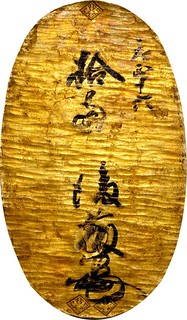
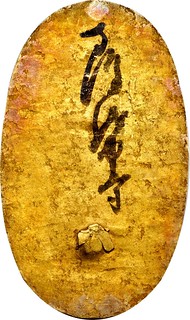
Tensho Era Japan Oban 10 First Oban
Beginning with the Hishi Oban, the first Oban of Japan, the immense rarity is clear, as it stands as one of just a few, possibly six, examples known. Many of these examples are held in museum collections and thus unobtainable to collectors. Meanwhile, another specimen, this time from the Genroku Era (ca. 1695-1704), stands apart due to its stunning beauty. Featuring nearly-choice quality and a rather dazzling iridescent tone, this piece offers exceptional eye appeal.
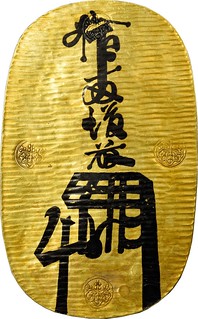
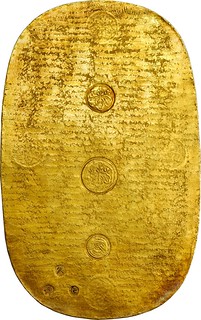
Kyoho Era Japan Oban 10 Rho Goto Signature Variety
A scarce Goto signature variety from the Kyoho Era (ca. 1725-1837) focuses on the inking, and exhibits stunning boldness with ink that is quite sharp and decisive, with the signature running over the edge at the base of the obverse. This outstanding subset of the Pinnacle Collection is sure to generate a great deal of enthusiasm among advanced collectors, allowing many the chance of a lifetime, whether it is the opportunity to acquire generational rarities or to simply view that which is normally relegated to the museum or the occasional catalog page.
For more information on the Stack’s Bowers and Ponterio April 2021 Hong Kong Auction or the Pinnacle Collection, visit the firm’s website at www.StacksBowers.com, call 800-458-4646, or email info@stacksbowers.com.
To view the auction online:
April 2021 Hong Kong - Session B - The Pinnacle Collection - Lots 50001-50162
(https://auctions.stacksbowers.com/auctions/3-QA5WI/april-2021-hong-kong-session-b-the-pinnacle-collection-lots-50001-50162)
To read the complete lot descriptions, see:
JAPAN. Hishi Oban (10 Ryo), ND Tensho Era (ca. 1588).
(https://auctions.stacksbowers.com/lots/view/3-QA5WW/japan-hishi-oban-10-ryo-nd-tensho-era-ca-1588-pcgs-ms-60-gold-shield)
JAPAN. Oban (10 Ryo), ND Genroku Era (ca. 1695-1704).
(https://auctions.stacksbowers.com/lots/view/3-QA6RU/japan-oban-10-ryo-nd-genroku-era-ca-1695-1704-pcgs-ms-62-gold-shield)
JAPAN. Oban (10 Ryo), ND Kyoho Era (ca. 1725-1837).
(https://auctions.stacksbowers.com/lots/view/3-QA6QF/japan-oban-10-ryo-nd-kyoho-era-ca-1725-1837-pcgs-ms-64-gold-shield)
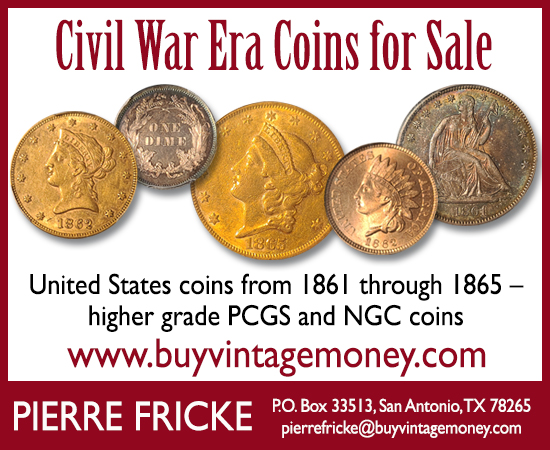
HERITAGE APRIL 2021 SALE FEATURES U.S. ERROR
This Heritage press release announces an interesting collection of U.S. error coins. Some great pieces here. -Editor
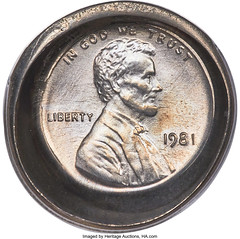
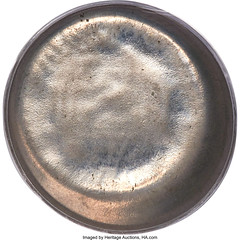
Errorpalooza Collection Turns Heads at Heritage Auctions – NOW open for bidding
A fabulous collection of error coins is coming up for bid soon at Heritage Auctions, featuring an error coin that could sell for $25,000+ on its own! The Errorpalooza Collection, under C#3945814, has not been entered yet but will be a highlight of both the Special Monthly Error Coin Auction #60197 and Signature Sale 1329.
The top lot from this collection is a 1981 Cent struck on a Nickel Planchet. It is common knowledge that error coins on the wrong planchet are usually only struck on SMALLER planchets, not bigger ones. Since a nickel planchet is bigger in diameter than those used for Lincoln Cents, this is a virtually impossible error that seems to have never been sold at Heritage before (or perhaps at auction at all.) It is anyone's guess what this one-of-a-kind coin may sell for, but there is a solid consensus that this is a 5-figure item.
Other great error coins in this collection include State Quarters struck on foreign planchets that were meant for coins from other countries, a Sacagawea Dollar struck on a State Quarter planchet in a lofty grade of MS68, and other fascinating "oops" moments from the US Mint. There should be plenty of exciting results when this group of 29 error coins comes up for bid in April!
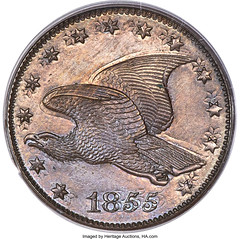
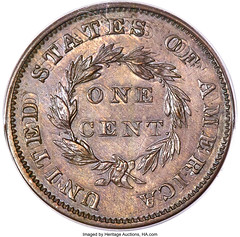
1855 P1C Flying Eagle Cent, Judd-168 Original, Pollock-193, R.4 -- Double Struck -- PR64 Brown PCGS: 1855 P1C Flying Eagle Cent, Judd-168 Original, Pollock-193, R.4 -- | Lot #91206 | Heritage Auctions (ha.com)
1981 1C Lincoln Cent -- Die Cap on 5C Planchet -- MS62 PCGS_Heritage_Auctions_1.jpg: https://coins.ha.com/itm/errors/1981-1c-lincoln-cent-die-cap-on-5c-planchet-ms62-pcgs-die-caps-occur-when-a-struck-coin-fails-to-eject-from-the-pres/a/60197-91045.s?ic4=ListView-Thumbnail-071515
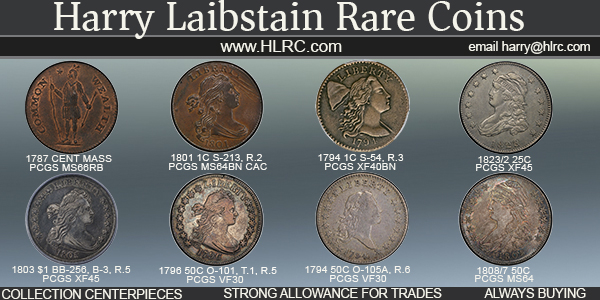
ENGELHARD ERROR BARS
On a related note, this week I came across a 2015 article on the ALL ENGLEHARD site about silver bars with stamping errors. -Editor
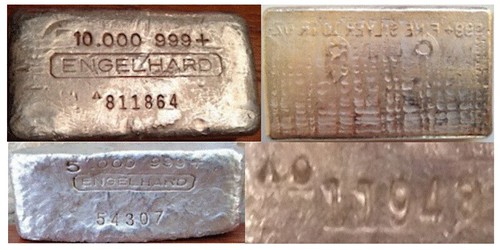
ENGELHARD ERror Bars VALUE… OR drama?
Both, actually. Any type of “collectible” that exhibits a visible production error or malfunction, particularly a oneof-a-kind example, has a varied and unpredictable level of collector appeal. One’s mind might immediately go to the 1969-S double die obverse Lincoln Cent where circulated examples bring tens of thousands of dollars for what would have otherwise been worth, well, just a penny. Several examples of this double die have been located, and it is believed that a brief flawed production run caused this error. Engelhard silver bars and ingots experienced similar production run flaws over their retail bullion tenure, although the most notable examples are predominantly the early hand stamped varieties. In fact, early varieties had frequent error examples, whether it was a double serial stamp, repeat serial number, reverse die stamp, or upside down stamp.
The ingot in the above lower left photo was taken from the AllEngelhard 5oz Definitive Page, and the entry displayed the caption “One too many.” I’m not sure if they are referring to the production error itself, or the inebriation of the person then in charge! Either way, the refinery worker unknowingly produced a collectible gem that is truly one-of-a-kind!
Production blunders very much demonstrate the alluring appeal and notability of mistakes, which happen for many different reasons, from complex production issues, to the more probable reality of simple human error. To illustrate on a larger scale, the Leaning Tower of Pisa was a huge structural engineering faux pas (by today’s standards) some 655 years ago. But would it have the same appeal and amore affair today if it were just the Tower of Pisa? Probably not. The intrigue is in the error. But one thing is for sure with collectibles, it pays to make mistakes. Or better stated, it pays to own examples of the mistakes of others!
While there is no formula or even chart pattern for valuations of Engelhard ingot and bar errors, they certainly do command a premium over their ‘normal’ counterparts. The final sale premium might be 10%, or maybe 100%, or perhaps even higher, but certainly the collector audience will seek out these examples, and the bidding frenzy will follow. Build it (wrong) and they will come!
If you own one of these gems, you should thank your lucky stars that “Joe” at Engelhard Industries maybe had ‘one too many’ that day back in the 1970’s, and let’s hope he didn’t lose a fingernail in the process!
To read the complete article, see:
ENGELHARD ERror Bars
VALUE… OR drama?
(https://allengelhard.com/wp-content/uploads/2017/08/AGWire-ENGELHARD-EERROR-BARS-5-21-15.pdf)
THE BOOK BAZARRE
ANCIENT GREEK COINS DISCOVERED IN ROMANIA
In the Make-Makedonon-Great-Again department is this reminder that political slogans are nothing new. -Editor
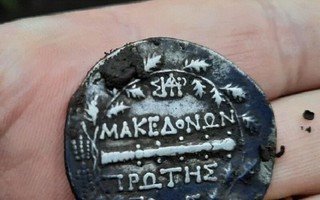 Dozens of ancient Greek coins were discovered recently by a retired policeman in a village in southern Romania.
Dozens of ancient Greek coins were discovered recently by a retired policeman in a village in southern Romania.
The haul of 68 coins was found with a metal detector near the village of Radomiresti, 140 kilometers (87 miles) west of Bucharest and and about 70 kilometers (44 miles) north of Bulgaria.
Police say the find could be “a real treasure” and the coins appear to be very old, minted in the 2nd century according to the retired officer who found them.
The coins bear the inscription “?a?ed???? ???t??” (“Makedonon first”) and are decorated with oak leaves.
Retired officer Paul Durca, who had a license to use a metal detector found the silver coins on land he owned and handed them over to the police department, Adevarul reported. They will be sent to the Culture Ministry to be authenticated and dated.
“After counting twenty-odd coins, I stopped and called the authorities,” the former officer said on Facebook, adding that going out with his metal detector was one of his hobbies.
“It’s a favorite pastime. Today on the 13th, the goddess of fortune and all the gods of fortune were with me. I dug up 68 coins from the 2nd century. Thank you Lord!” the finder wrote jubilantly.
Found via The Explorator newsletter. To subscribe to Explorator, send a blank email message to: explorator+subscribe@groups.io. -Editor
To read the complete article, see:
Dozens of Ancient Greek Coins Discovered in Romania
(https://greekreporter.com/2021/03/16/dozens-ancient-greek-coins-discovered-romania/)

AINA COL. DAVID "MICKEY" MARCUS MEDAL
In 2019 the American-Israeli Numismatic Association (AINA) produced a great medal honoring Col. David "Mickey" Marcus. Here's some additional background from the designer Joel Iskowitz that I came across this week on Facebook. -Editor
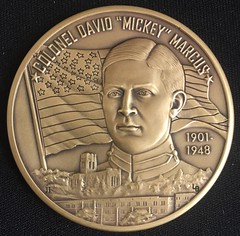
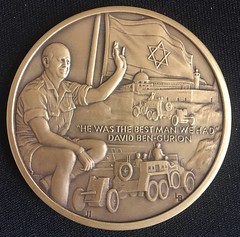
I didn't know anything about this American and Israeli hero before conducting research in preparation for designing this medal in honor of Col. David Daniel "Mickey" Marcus, commissioned by the American-Israeli Numismatic Association.
An athletic, bright, tough street kid from Brooklyn, N.Y., he went on to graduate from West Point, serve with distinction in WWII, volunteering to parachute into Normandy on D-Day with the 101st Airborne Division. In 1946 he was named Chief of the Army's War Crimes Division documenting Nazi war crimes for the Nuremberg Trials as well as the Tokyo War Crimes Tribunal. In 1948 he was instrumental in the Haganah and was appointed ALUF (General). For his valor and service to the fledgling nation of Israel, he was lauded by David Ben-Gurion as "The best man we had".
Ironically, he was tragically shot to death by an Israeli sentry hours before the cease fire. As a secular Jew, who did not speak Hebrew, he failed to provide the password, and the sentry did not understand his English. Marcus' grave is the only one at West Point Cemetery for an American killed fighting under the flag of another nation.
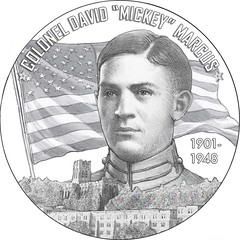
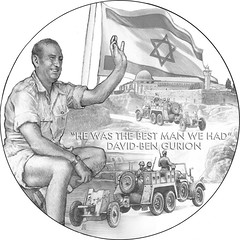
His gravestone reads "Colonel David Marcus—a Soldier for All Humanity" The designs were sculpted by the brilliant Luigi Badia.
To read the complete article, see:
https://www.facebook.com/joel.iskowitz/posts/10157107580264594
To read the earlier E-Sylum article, see:
ISKOWITZ MEDAL DESIGN HONORS MICKEY MARCUS
(https://www.coinbooks.org/v22/esylum_v22n22a31.html)
WESTERBORK CENTRAL REFUGEE CAMP SCRIP
Here's a Google-translated article from Geldschiene-Online by Hans-Ludwig Grabowski about the "Jewish transit camp" Westerbork and its paper money. Found via News & Notes from the Society of Paper Money Collectors (Volume VI, Number 40 March 23, 2021). -Editor
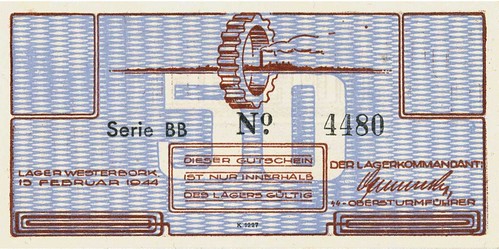
In mid-December 1938, the Netherlands closed its borders to refugees from the German Reich in the interests of friendly relations with its German neighbors. From this point on, they were neither welcome nor should they be integrated. In February 1939, the Dutch government decided to build a reception center near Westerbork to accommodate the mainly Jewish refugees. A first group arrived here on October 9, 1939.
When German troops marched into the Netherlands on May 10, 1940 to “protect Dutch neutrality” and to prevent British forces from landing on the continent, around 700 people were in the “Central Refugee Camp Westerbork”.
The "Kamp Westerbork" was taken over by the German occupation and continued utilized. German Jews arrested or volunteered in the Netherlands were arrested.
After the decision was made at the end of 1941 to use Westerbork as the central transit camp for the mass deportation of Dutch Jews, the camp was placed under the command of the Security Police and the Security Service (BdS) on July 1, 1942, and became the "Police Jewish Transit Camp"
In 1943/1944, various workshops were set up in which the prisoners had to work until they were deported, including a tailor's shop, a linoleum factory and the "storage industry" in which aircraft, apparatus, batteries and cables are dismantled and metals, foils and waste are sorted for recycling were.
The appearance of normalcy was preserved in the camp itself. The reign of terror common in concentration camps was largely dispensed with, there was a school, a hospital and an orphanage, sporting events and even an orchestra of its own. Instead of Kapos and SS, Westerbork had its own Jewish police with the security service, which is also known from ghettos.
The last transport left Westerbork on September 13, 1944 with 279 people in the direction of Bergen-Belsen. Ten days earlier, Anne Frank, who became world-famous through her diary and a symbolic figure for the victims of the Holocaust, had also left Westerbork on the way to Bergen-Belsen, where she died of typhus in early March 1945.
Vouchers from the Westerbork camp
The Westerbork camp vouchers have nothing to do with the SS premium regulation of May 15, 1943 or its amendment of February 14, 1944, even if they were listed at Pick / Siemsen under premium vouchers. 2) Rather, it is storage money, as it was used in the other Dutch camps (Amersfoort and Herzogenbusch) and which should reduce the risk of escape by withholding the cash. It was also used to pay for labor for prisoners in the camp and to skim off their regular means of payment. Until its introduction, the use of cash in the Camps were common, as were money transfers to prisoners in Dutch guilder currency.
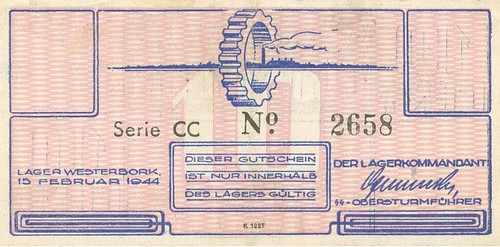
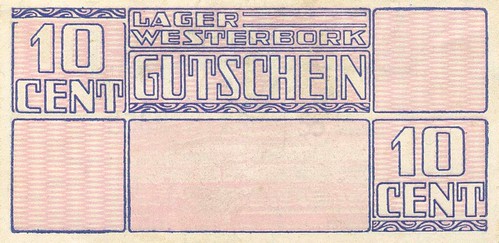
The front of the notes shows the warehouse designation and the face value, a logo with a gear wheel as a symbol of work. On the back there is a view of the warehouse in the negative pressure. All values ??were produced in three series (AA, BB and CC) at the Van de Kamp print shop in Groningen (printer identification K 1227).
Design and colored printing (overprint and underprint) are comparatively complex and modern, but this is also known from the other Dutch camps.
The back shows a view of the warehouse with a warehouse road and a smoking chimney.
Individual print samples and unfinished notes as well as misprints (e.g. with shifted print on the back) and incorrect cuts are known of the Westerbork storage money.
After the liberation of the camp, prisoners took several hundred series of used notes with them. About 20 years ago these came onto the collector's market, which is why they are not unusually rare today.
To read the complete article, see:
Das "Judendurchgangslager" Westerbork und sein Geld
(https://www.geldscheine-online.com/post/das-judendurchgangslager-westerbork-und-sein-geld)

BANK OF ENGLAND £50 ALAN TURING BANKNOTE
Howard Berlin passed along this article about the new banknote honoring mathematician Alan Turing. Thanks! A giant we all owe a debt of gratitude to today. -Editor
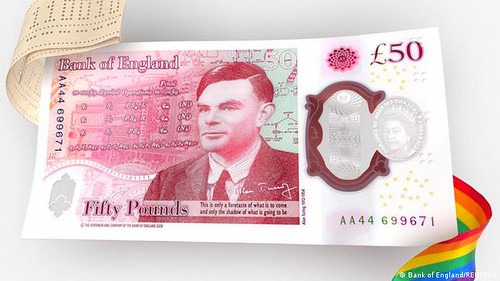
Alan Turing's image, along with a landmark mathematical formula he developed, will be featured on Britain's highest-value bank note.
The new bank note carries a mathematical formula that Turning wrote in a 1936 paper that laid the groundwork for modern computer science.
The note also features a quote by Turing about the rise of machine intelligence: "This is only a foretaste of what is to come, and only the shadow of what is going to be."
The £50 note will enter circulation on June 23, Turing's birthday. It is the Bank of England's highest-value bank note. Turing replaces steam engine pioneers James Watt and Matthew Boulton.
Turning cracked the Nazi Enigma code by building on the works of Polish mathematicians who discovered how to read it.
He built an electro-mechanical machine, which foreshadowed the computer, to break the "unbreakable" code that Nazis used to pass orders to their command chain.
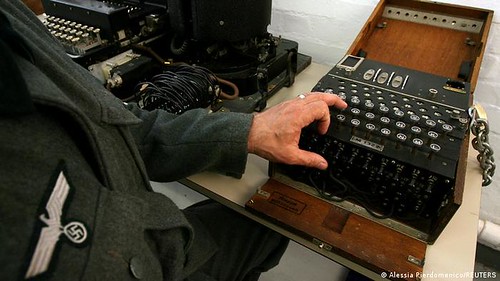
He also developed the a test to determine if machines are capable of human-like intelligent behavior. The "Turing test" became cornerstone of the philosophy and ethics of what is now known as artificial intelligence.
The head of GCHQ, Jeremy Fleming, said Turing's image on the note was a historical moment.
"Turing was embraced for his brilliance and persecuted for being gay. His legacy is a reminder of the value of embracing all aspects of diversity, but also the work we still need to do to become truly inclusive," Fleming said.
In 2013, Queen Elizabeth granted Turning a royal pardon for the 1952 criminal conviction. A year later, the film The Imitation Game, which won an Oscar, showcased Turing's story.
To read the complete article, see:
Britain unveils £50 Alan Turing bank note celebrating WWII codebreaker
(https://www.dw.com/en/britain-unveils-50-alan-turing-bank-note-celebrating-wwii-codebreaker/a-56985991)
It's an excellent film - check it out sometime. -Editor
To read additional articles, see:
WWII codebreaker Alan Turing honoured on new UK bank note
(https://www.aljazeera.com/news/2021/3/25/wwii-codebreaker-alan-turing-honoured-on-new-uk-bank-note)
New £50 note featuring Alan Turing to enter circulation in June
(https://www.theguardian.com/science/2021/mar/25/new-50-note-alan-turing-banknote-enigma)

£10 NOTE MISSING QUEEN'S FACE
This item from the Mirror describes an interesting note discovered at an ATM machine. Is it a legitimate error, or some post-printing shenanigans? Unusual item either way. Also found via News & Notes from the Society of Paper Money Collectors (Volume VI, Number 40 March 23, 2021). -Editor
Peter Coleman, 72, was surprised when he took the £10 from an ATM and spotted that the Queen was missing.
The grandfather-of-three then tried to use the note in a shop, where a worker said she could not accept it as it was not legitimate.
But when she scanned the money she conceded that it was 'real' - giving Peter, from Littleborough, Greater Manchester, a bright idea.
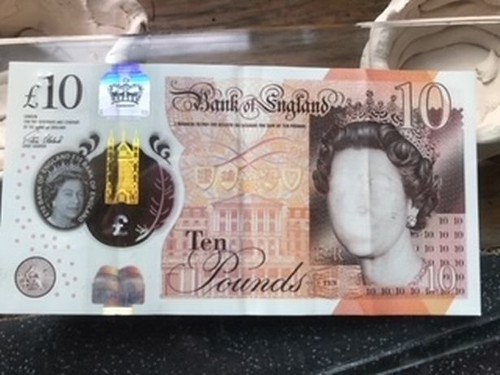
"I just thought that it was very unusual and that it could be a sign."
An article in yesterday's Coin World by Arthur Friedberg concurs with my suspicion - it's not that hard to scrape design elements off the polymer substrate, and this is unlikely to be a genuine production error. -Editor
To read the complete article, see:
Rare 'faceless' £10 note withdrawn from cash machine could net pensioner a fortune
(https://www.mirror.co.uk/news/uk-news/rare-faceless-10-note-withdrawn-23721485)
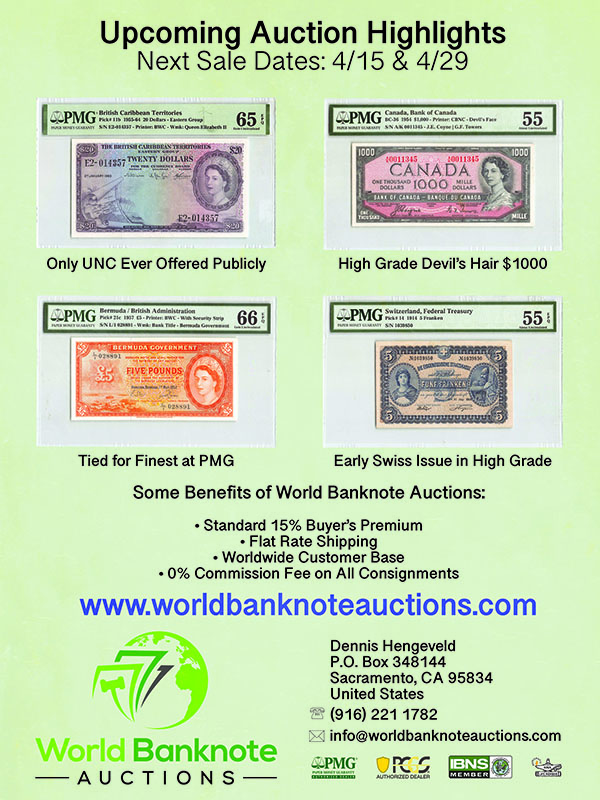
BANK OF ENGLAND £50 NOTE TEXTURE FEATURES
The new £50 Bank of England note includes textured features for the blind. -Editor
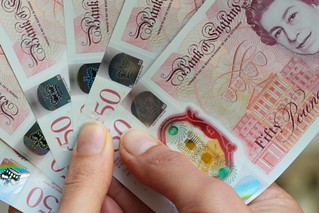 The Bank of England said it will add four clusters of raised dots to the top-left corner of its new £50 note, meaning all the notes in circulation in the U.K. will be distinguishable to people who are blind or partially sighted.
The Bank of England said it will add four clusters of raised dots to the top-left corner of its new £50 note, meaning all the notes in circulation in the U.K. will be distinguishable to people who are blind or partially sighted.
The £50 note—worth roughly $69—is the highest-value bill in circulation in the U.K. and was the last denomination to be redesigned for printing onto plastic polymer material.
The U.K. central bank is the latest national authority to make all its bank notes accessible to people who are blind or partially sighted with the addition of tactile markers. Accessibility advocates have been pressing the U.S. Treasury to make similar changes to the design of its paper currency, which they say makes it difficult for people with no or little vision to distinguish between bills.
“Because all our bank notes essentially look and feel the same, it’s just not possible to identify them without some sort of external assistance,” said Aaron Preece, the editor in chief of AccessWorld, an online technology magazine published by the American Foundation for the Blind.
The Bank of England, working with the Royal National Institute of Blind People, added the dots to its £10 note in 2017 and to its £20 bill last year. The £5 note is now the only bill that isn’t printed with textured elements, but people can identify it by the lack of them, said Sarah John, the chief cashier of the Bank of England.
The new features were enabled by the switch to printing currency on polymer, which holds the shape of the raised bumps much better than paper, Ms. John said.
Similar tactile markers appear on other currencies including Australian dollars, Canadian dollars and the euro.
In the U.S., however, bills not only lack textured markers but are similar in color and shape. Other countries’ bank notes often have differing colors and contrasts, making it easier to tell denominations apart.
To read the complete article (subscription required), see:
Bank of England’s Textured Bills Help Blind People Tell Them Apart
(https://www.wsj.com/articles/bank-of-englands-textured-bills-help-blind-people-tell-them-apart-11616772483)

VIRTUAL MARKET ENJOYS ASTONISHING SUCCESS
We've earlier discussed how third-party grading and authentication services for numismatics later moved to the sports collectibles field, where much frenzied trading and innovation is happening today. This story discusses a new trading platform for purely virtual assets - could something like this enter the numismatic marketplace as well? -Editor
Fans have been flocking by the thousands to the Top Shot online platform to buy short videos of dramatic sequences from professional basketball games, as a new virtual market enjoys astonishing success among collectors, sports fans and art lovers.
To the untrained observer, one video clip showed NBA superstar LeBron James in one of his more spectacular moves; but it lasted no more than a few dozen seconds. On Top Shot, however, it instantly became a collector's item that sold on Monday for an eye-popping $208,000.
The video sequence is an "NFT" -- a Non-Fungible Token -- a virtual object whose identity, authenticity and traceability are theoretically indisputable and tamper-proof, thanks to the same "blockchain" technology used to ensure the security of cryptocurrencies like the hugely popular bitcoin.
After a slow start, Top Shot's business has exploded since January, generating more than $200 million in transactions since the start of the year, according to a Dapper Labs spokeswoman.
By Wednesday, Top Shot was approaching its first 100,000 buyers, she added.
The Momentranks website, which says it provides "accurate, real-time moment valuations," puts the current value of the market at $1.8 billion.
Paradoxically, most of the video clips being sold can be viewed for free elsewhere on the internet, primarily on YouTube.
"I totally understand the initial reaction of 'I don’t get it' or 'This seems stupid,'" Jonathan Bales, who spent $35,000 for one "moment," wrote on his Lucky Maverick blog. "But guess what? There’s a whole generation of young, smart people who’ve grown up in a fundamentally different way from me and you, so whether or not we 'get' the future is irrelevant to how it will transpire."
Steve Poland, creator of the Mighty Minted site, recalled his own initial reaction.
"I signed up for an account, and then just instantly, it just clicked, it was like, this is the future. And this is now. And this is what collectibles are going to become in the future."
Fans of NFTs see them as an alternative to traditional collectors' markets that are often unregulated and opaque, whether involving sales of baseball cards or art works by masters.
"The technology is better than the offline world stuff," said Poland. "I mean, there are fake Picasso's out there, there are fake Van Gogh's out there (whereas) these are confirmed to be real."
NFT-based art, Davis added, is "on the threshold of becoming the next ingeniously disruptive force in the art market."
NFT has a great future in the sports world as well, Poland says.
On Thursday, French soccer platform Sorare announced that it had raised $50 million from investors.
And the Italian-based Panini company, long involved in the trading-card business and other collectibles, said it has also created its own blockchain-based site.
To read the complete article, see:
Digital authentication opens new doors for art, sports collectors
(https://news.yahoo.com/digital-authentication-opens-doors-art-015902230.html)
For more information on NBA Top Shots, see:
https://www.nbatopshot.com/

PERSONAL PHOTO ORGANIZERS
At last week's NNP Symposium panel session on the early days of online numismatics we talked a bit about the evolution of technology and how it changed the hobby and the profession. This New Yorker article describes one growing profession you may not have thought of, but which is now a real thing. -Editor
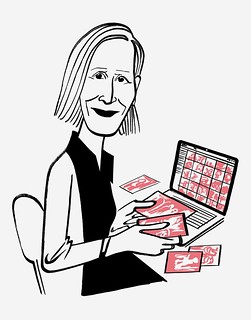 Elevator operator became a job sometime in the latter half of the eighteenth century, first appearing as its own category on the U.S. Census in 1910. It is the only job since 1950, according to a recent study, to have been fully eliminated by automation. Occupations come and go, their life spans following trend and technology. Town criers, soda jerks, lamplighters, clock winders, pinsetters, and ice cutters give way to air-traffic controllers, genetic counsellors, drone operators, influencers, and social-media managers. The other day, a journalist was scrolling through Instagram and spotted an interesting-sounding gig in another user’s bio: personal-photo organizer.
Elevator operator became a job sometime in the latter half of the eighteenth century, first appearing as its own category on the U.S. Census in 1910. It is the only job since 1950, according to a recent study, to have been fully eliminated by automation. Occupations come and go, their life spans following trend and technology. Town criers, soda jerks, lamplighters, clock winders, pinsetters, and ice cutters give way to air-traffic controllers, genetic counsellors, drone operators, influencers, and social-media managers. The other day, a journalist was scrolling through Instagram and spotted an interesting-sounding gig in another user’s bio: personal-photo organizer.
A call to Fort Greene (no operator necessary) confirmed that personal-photo organizing is, indeed, an emerging profession, and that people who spend their days swiping and saving in the name of posterity are also known as family-photo curators. “Photo managers can help organize and curate collections, digitize prints, suggest backup systems, re-house in archival storage, and help you tell your story through photo book design, videos, websites, and countless other ways,” reads the Web site of the Photo Managers (formerly the Association of Personal Photo Curators), est. 2009.
A family once hired Dervaux for eighty hours, to curate their photos and be done with it, but she prefers a pedagogical approach, working side by side with a client, so that the client can do his or her own sentimental labor in the future. The goal is to whittle every year’s collection down to no more than twelve hundred keepers (“faved” on an iPhone), a couple of hundred selections for a digital album, and, finally, twelve to fifteen “best” photos that would qualify for a holiday card or to hang on a wall.
Swiping around in strangers’ camera rolls is not without occupational hazards. Dervaux has stumbled across nudes, birthing closeups, and enough is-this-a-rash-or-what selfies to overwhelm a dermatologist. The process of sorting through photos is, in many ways, a process of sorting through emotions. “Some people don’t want to see their ex-husband pop up on the screen,” Dervaux said. “We’ll export those so they won’t be mixed up with your new husband.” Photos, she said, fall into three categories: 1) family, friends, and memories; 2) places and things; and 3) practical information (a screenshot of a bike-rental agreement, a recipe, a class schedule). “In the past, we were photographing physical things to remember the past,” she said. “But now what we do is we photograph ideas. We photograph things for the future, like a number we want to call.”
Curate a family’s photos and they’ll be organized for a day; teach them how to take better pictures and they’ll be organized forever. “My philosophy is Let’s try not to take a picture that you’re going to have to delete later,” Dervaux said.
I can't help but think there must be the numismatic equivalent of such a profession, and not just for the grading and auction houses, but for the rest of us. Our own personal digital curator. One can dream, can't one? -Editor
To read the complete article, see:
How a Personal-Photo Curator Separates the Is-This-a-Rash Selfies from the Keepers
(https://www.newyorker.com/magazine/2021/03/29/how-a-personal-photo-curator-separates-the-is-this-a-rash-selfies-from-the-keepers)
PAUL MANSHIP EXHIBIT
John Mellman noticed this Wall Street Journal article about an exhibit of the work of sculptor Paul Manship. Thanks. It didn't mention his numismatic work, which included both coins and medals. Worth a look though, for great images of his amazing artwork. -Editor
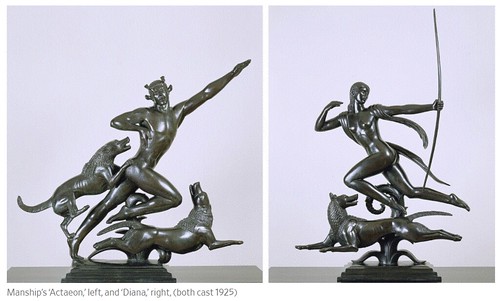
Though long since overshadowed by abstract and later sculptors, Manship was for a time in the early decades of the 20th century the most important and popular sculptor in the U.S. Whether they know it or not, many people, especially residents and tourists in New York, have admired his works, which include the monumental gilded “Prometheus” (1934) at Rockefeller Center; the “Group of Bears” (1932, cast 1963) at the Metropolitan Museum of Art; and the “Rainey Memorial Gates” (1934) that include lions, tortoises and bears at the Bronx Zoo.
In other words, this exhibition reveals how Manship became Manship, how he melded his interests in ancient art and mythological tales with early 20th century sensibilities to make something new, a style that bloomed into Art Deco.
To read the complete article (subscription required), see:
‘Paul Manship: Ancient Made Modern’ Review: Classical Figures for the 20th Century
(https://www.wsj.com/articles/paul-manship-ancient-made-modern-review-classical-figures-for-the-20th-century-11616013899)
To read the earlier E-Sylum article, see:
PAUL MANSHIP EXHIBIT AT THE WADSWORTH
(https://www.coinbooks.org/v24/esylum_v24n09a34.html)
THE 500-POUND POMADED PENNY PILE
It's been a while since we've seen a pile-of-revenge-pennies story. Dave Schenkman passed along this article. -Editor
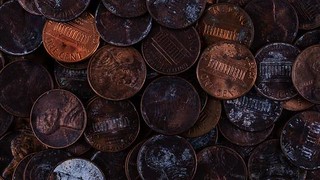 Revenge is a dish best served cold—or greasy, perhaps. A Fayetteville, Georgia, man tells CBS 46 that he gave his two weeks' notice at A OK Walker Autoworks in November 2020 but hadn't been sent his last paycheck in January as promised, a fact that prodded him to reach out to the Georgia Department of Labor. Andreas Flaten did end up getting the $915 he was expecting, just in a most unexpected format. Flaten says a 500-pound pile of oil- or grease-covered pennies was left on his driveway. He tells Fox 5 Atlanta the pile of more than 90,000 coins was accompanied by an envelope with f--- you written on the outside and his final paystub within.
Revenge is a dish best served cold—or greasy, perhaps. A Fayetteville, Georgia, man tells CBS 46 that he gave his two weeks' notice at A OK Walker Autoworks in November 2020 but hadn't been sent his last paycheck in January as promised, a fact that prodded him to reach out to the Georgia Department of Labor. Andreas Flaten did end up getting the $915 he was expecting, just in a most unexpected format. Flaten says a 500-pound pile of oil- or grease-covered pennies was left on his driveway. He tells Fox 5 Atlanta the pile of more than 90,000 coins was accompanied by an envelope with f--- you written on the outside and his final paystub within.
Fox 5 says the autoshop owner would only confirm that Flaten was paid what he was owed in US currency. As for Flaten, he says he now spends time each night working to rid the 91,515 pennies of their slick coating using a mix of dish soap, vinegar, and water. It's apparently quite the effort: He says working his way through several hundred took 90 minutes, and that he won't be able to cash them until they're clean.
To read the complete article, see:
Man Says Ex-Boss Paid Him in 500 Pounds of Gross Pennies
(https://www.newser.com/story/304083/man-says-ex-boss-paid-him-in-500-pounds-of-gross-pennies.html)
Howard Berlin sent an Associated Press version. -Editor
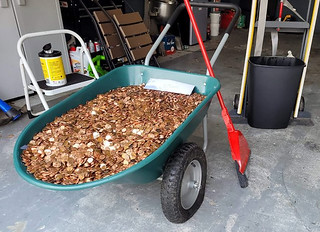 Flaten’s girlfriend, Olivia Oxley, said she hopes her boyfriend’s story sheds light on how people “are treated so poorly by their employers.”
Flaten’s girlfriend, Olivia Oxley, said she hopes her boyfriend’s story sheds light on how people “are treated so poorly by their employers.”
She said the pair have stopped being angry and are looking at the petty act in a positive light.
“With that many pennies, we’re bound to find a few treasures. I’ve already found one from 1937,” Oxley said. “After the first shovel full, all we could do was laugh because this poor miserable man took so much time to be vindictive and cruel. We absolutely refused to let him ruin a single moment of ours.”
To read the complete article, see:
Penny dreadful: Georgia man receives final paycheck in coins
(https://apnews.com/article/georgia-man-final-paycheck-915-coins-0fe966a8ea0fbd1a9559d1222081aa5f)
The story went viral this week, appearing in multiple outlets. The best is from The New York Times. Thanks also to Dennis Tucker, Aaron Oppenheim, Dick Hansom, Arthur Shippee, and others who forwarded articles. -Editor
Regarding the BBC News story, Arthur Shippee writes:
"Oy! & the stock photo!!!"
Dennis Tucker writes:
"I pray that "Georgia Business" doesn't overtake "Florida Man" in the Bizarre News category. Isn’t there a numismatic group he can join — Oily American Coppers, I think they’re called?"
To read the other articles, see:
A Man Demanded His Final Paycheck. The Auto Shop Delivered 91,500 Greasy Pennies.
(https://www.nytimes.com/2021/03/25/business/auto-shop-pennies.html)
Georgia man receives last paycheck in oily pennies dumped on his driveway
(https://www.foxnews.com/us/georgia-man-receives-last-paycheck-in-oill-pennies-dumped-on-his-driveway)
Auto worker employee receives 91,500 pennies in final wages
(https://www.bbc.com/news/world-us-canada-56521173)
He demanded his last paycheck, so his ex-boss dumped 91,515 oily pennies on his driveway
(https://www.washingtonpost.com/nation/2021/03/25/he-demanded-his-last-paycheck-so-his-ex-boss-dumped-91515-oily-pennies-his-driveway/)
FEATURED WEB SITE: FIDEM
This week's Featured Web Site is FIDEM, the Fédération Internationale de la Médaille d'Art (International Art Medal Federation).
FIDEM brings together publicly recognised national organisations concerned with medallic art. It works for the creation of such organisations in countries where none exists. It also brings together other organisations and private individuals interested in medallic art.
